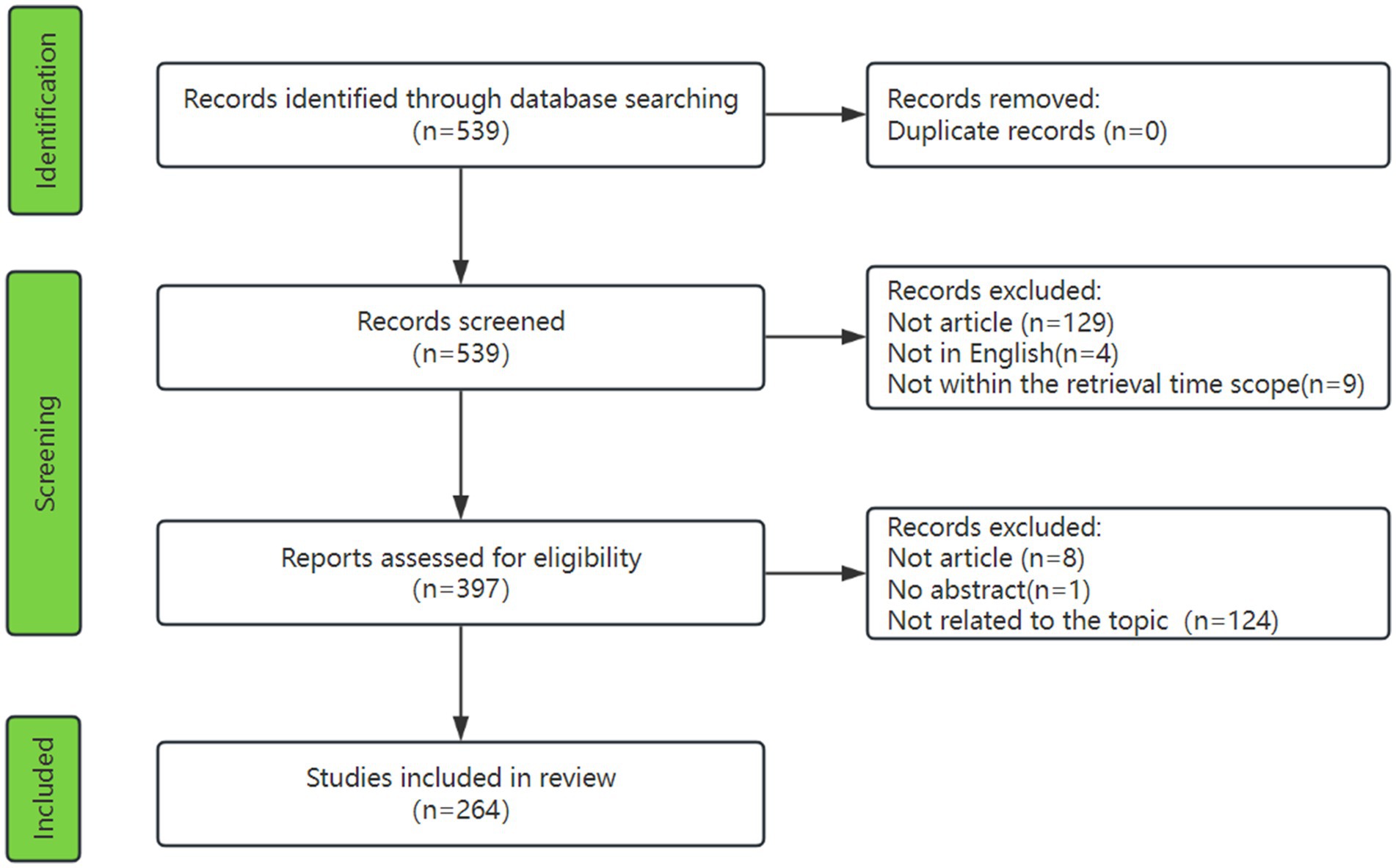- 1Department of Basic Medical Sciences, Qinghai University Medical College, Xining, China
- 2Department of Clinical Laboratory, Qinghai Provincial People’s Hospital, Xining, China
- 3Research Center for High Altitude Medicine, Key Laboratory for High Altitude Medicine, Ministry of Education, Qinghai University, Xining, China
Background: Acinetobacter baumannii is a common hospital pathogen that poses a serious clinical challenge due to its rapidly increasing resistance to antibiotics. Phage therapy has been successfully used to treat antibiotic resistant A. baumannii infections. The aim of this study was to comprehensively assess the current status and trend of research on the application of phages in A. baumannii infections through bibliometric analysis.
Methods: Studies on phages and A. baumannii infections were searched in the Web of Science Core Collection database and relevant articles were selected for inclusion in the study based on the inclusion criteria. Bibliometric and visual analysis of the included publications were performed using VOSviewer and CiteSpace software.
Results: A total of 264 studies were included. There is an increasing trend in the number of publications per year from 2010 to 2024. China was the leading country with 35.98% of the total publications. Tzu Chi University and Lin, Nien-Tsung were the most influential institution and author, respectively. The journal with the highest H-index was Frontiers in Microbiology, and Viruses-Basel was the most prolific journal. Antimicrobial Agents and Chemotherapy was the most cited journal. Phages endolysin and phage therapy were found to be the widely researched aspects, biofilm, phage resistance and synergistic effect are recent research hotspots.
Conclusion: In the last decade or so, this is the first bibliometric study that systematically describes the research hotspots and development trends on phages in A. baumannii infections. Research hotspots should be given more attention.
1 Introduction
Acinetobacter baumannii is an important Gram-negative pathogenic bacterium that is widespread in nature (Pandey et al., 2022). It can cause a variety of infections including meningitis, endocarditis, ventilator-associated pneumonia in intensive care, urinary tract infections and bacteremia (Antunes et al., 2014; Li et al., 2023). Study showed that the six leading pathogens for deaths associated with resistance were responsible for 929,000 deaths attributable to Antimicrobial resistance (AMR) and 3.57 million deaths associated with AMR in 2019, and that A. baumannii is one of them (Antimicrobial Resistance Collaborators, 2022). Furthermore, A. baumannii has demonstrated a remarkable ability to rapidly evolve resistance to conventional antibiotics, leading to the emergence of multidrug-resistant A. baumannii (MDRAB), extensively drug-resistant A. baumannii (XDRAB) and pan-resistant A. baumannii (PDRAB) strains. In particular, carbapenem-resistant A. baumannii (CRAB) is on the World Health Organization (WHO) list of critical priority bacteria for which new antimicrobial strategies are urgently needed (Tacconelli et al., 2018). As current antibiotics are becoming ineffective and there are still some challenges in the discovery and synthesis of new antibiotics, much effort has been directed towards the development of new therapeutic options to combat AMR, including phage or phage therapeutics, phage-encoded products, etc. (Chang et al., 2022). As of today the application of phages as antimicrobial agents has received increasing attention as a promising and safe therapeutic supplement for the treatment of bacterial infections (Nale and Clokie, 2021; Satta et al., 2022).
Phages are the most abundant and ubiquitous organisms on Earth and play important roles in microbial physiology, population dynamics, evolution and therapy (Clokie et al., 2011). Specifically speaking, because they are viruses, phages can target and kill their specific host bacteria, including antibiotic-resistant strains. Phages with a forced lysis life cycle are used in phage therapy, where they inject their genetic material into host bacteria, replicate themselves and then release their progeny through lysis. Unlike antibiotics, phages have high host specificity and low intrinsic virulence, minimizing interference with normal flora (Chang et al., 2020; Chang et al., 2022; Chang et al., 2018; Chang et al., 2017). Since the early 1920s, phages have been considered as therapeutic agents due to their unique antimicrobial capacity. Phages are considered to be one of the most promising alternatives to conventional antibiotics due to their high antibacterial capacity, large number (1030 ~ 1032 in the earth), low toxicity and side effects to humans (Hibstu et al., 2022; Tu et al., 2023; Uyttebroek et al., 2022).
Phage therapy relies on the precise use of phages to attack and kill bacteria and effectively control infections (Abedon et al., 2011). Since the first report of the protective effect of phage BS46 on mice infected with A. baumannii strain AC54 (Soothill, 1992), more and more phages have been identified for lysing A. baumannii, and some phages have even shown promising antimicrobial properties in animal models (Wang et al., 2023). In addition to live phages, some phage-derived enzymes, such as intracellular lysins and depolymerases, have been shown to possess bactericidal activity (Chen et al., 2022; Chu et al., 2022). Furthermore, the efficacy and safety of phage therapy has been demonstrated (Zhang et al., 2022). Case reports of pneumonia (Cha et al., 2018), wound infections (Regeimbal et al., 2016), bacteraemia (Leshkasheli et al., 2019) and sepsis (Jasim et al., 2018), as well as phage therapy targeting patients with a variety of diseases that are carbapenem-resistant or MDRAB demonstrate the potential value of phage therapy in clinical practice (Schooley et al., 2017; Tan et al., 2021; Wu N. et al., 2021). The most common phage therapies currently used against A. baumannii include single phage therapies (McCallin et al., 2018), phage mixtures (Molina et al., 2021), phage-antibiotic combination therapies (Luong et al., 2020b), and novel phage therapies such as phage-derived enzymes (Oliveira et al., 2018) and photosensitizer combination therapies (Ran et al., 2020; Zhang et al., 2022). Phage therapy has also been reported as a promising alternative to address the ongoing problem of A. baumannii biofilm infections (Teymouri et al., 2024).
Bibliometric analysis is a statistical method based on public literature databases that allows for quantitative and qualitative evaluation of publications to assist in analyzing research hotspots and trends in specific fields (Zhang et al., 2020). To the best of our knowledge, no bibliometric analysis have been published on the use of phages in A. baumannii infections. In this study, we aimed to use quantitative methods to analysis the application of phages in A. baumannii infections, to identify the main contributors and the current state of research in this field, and to suggest future research trends.
2 Materials and methods
2.1 Data source
The data analyzed are based on the Web of Science Core Collection (WOSCC) database. We chose WOSCC as a data source because it is more selective than other databases in terms of scientific coverage (Gazzaz et al., 2020). WOSCC is considered to contain not only the most comprehensive publications and high-quality indexes (Gazzaz et al., 2020), but also complete references and citations (Mongeon and Paul-Hus, 2016), making it a more comprehensive data source and the most widely used database in bibliometric research.
2.2 Search strategy
All studies until February 22, 2025 were retrieved and downloaded from the WOSCC database. The search strategy to obtain articles on phages in A. baumannii infections involved “TS = (Phage OR Phages OR Bacteriophage) AND TS = (Acinetobacter baumannii OR Bacterium anitratum).”
2.3 Data extraction
All relevant publications were independently assessed by two authors (Ping Jiang and Xiaoqin Luo) in two stages. In the first stage of screening, the language of publications was limited to English. In addition, non-article studies (reviews, conference proceedings, letters, etc.) were excluded from our study. In the second stage, the titles and abstracts of the remaining studies were carefully assessed and selected to include only articles that focused on phages in A. baumannii infections, using the following criteria: P (patients): studies involving patients with A. baumannii infections, animal models of A. baumannii infections and cellular models of A. baumannii infections; I (interventions): application of phages; S (study design): clinical and basic research. Disagreements were resolved by discussion.
2.4 Data analysis
The included publications and cited references were exported in plain text and subsequently analyzed for bibliometric and visualization purposes. VOSviewer (version 1.6.20, Leiden University, Leiden, The Netherlands), Scimago Graphica (Version 1.0.35, SRG S.L. company, Granada, Spanish), CiteSpace (version 6.3.R1, Drexel University, Philadelphia, PA, USA) and GraphPad Prism (version 10, GraphPad Prism Software Inc., San Diego, CA, USA) were used to generate tables and visual graphs. GraphPad Prism is used to generate line graphs of number of publications per year, number of citations, H-index, etc. Scimago Graphica is used to draw a map of the geographic distribution of publications. VOSviewer to create visual graphs and analyze the most productive/collaborative countries, institutions and authors, as well as the most cited journals and most co-occurrence keywords. CiteSpace for creating timeline graphs and keyword bursts. Each point on the visualization map represents a country, institution, author or journal, and these points are grouped according to their collaboration. The size of the dots depends on the number of publications. The thickness of the connecting lines connecting the nodes represents the strength of the collaboration between the nodes and the total link strength (TLS) reflects the overall level of collaboration. In the keyword analysis, some meaningless keywords were excluded and keywords with the same meaning were merged to get a better perspective. The modularity value (Q-value) > 0.3 and the average profile value (S-value) > 0.7 of the graphs generated by CiteSpace indicate that the clustering is significant and reasonable (Ling et al., 2023).
3 Results
3.1 Study selection and characteristics
As shown in Figure 1, a total of 539 publications were identified from the WOSCC database by searching for keywords related to phage and A. baumannii, and no duplicates were found. At the first selection stage, 4 publications were excluded due to language restrictions and 129 publications were excluded due to publication types. Nine publications were excluded because they were not within the retrieval time scope. The remaining 397 publications were carefully evaluated in the second stage using article titles and abstracts. Finally, A total of 264 studies that met the inclusion criteria were selected.
3.2 Analysis of the annual output of publications
The number of academic papers published each year provides insight into the past of the field and predicts its future development, and is an important indicator for visually assessing trends in scientific research. We then summarize the characteristics of the included studies. The distribution of the number of annual publications from 2010 to 2025 is shown in Figure 2a. The overall increasing trend in the number of annual publications indicates an increased interest in the field of phage and A. baumannii infections, peaking in 2024 with 48 publications, representing 13.18% of the total number of publications. The cumulative number of publications increased steadily from 2010 to 2025 (Figure 2b). The number of citations was relatively high from 2016 to 2021, with more than 700 citations per year (Figure 2c). The annual H-index increased from 2 in 2010 to 17 in 2019 (Figure 2d).
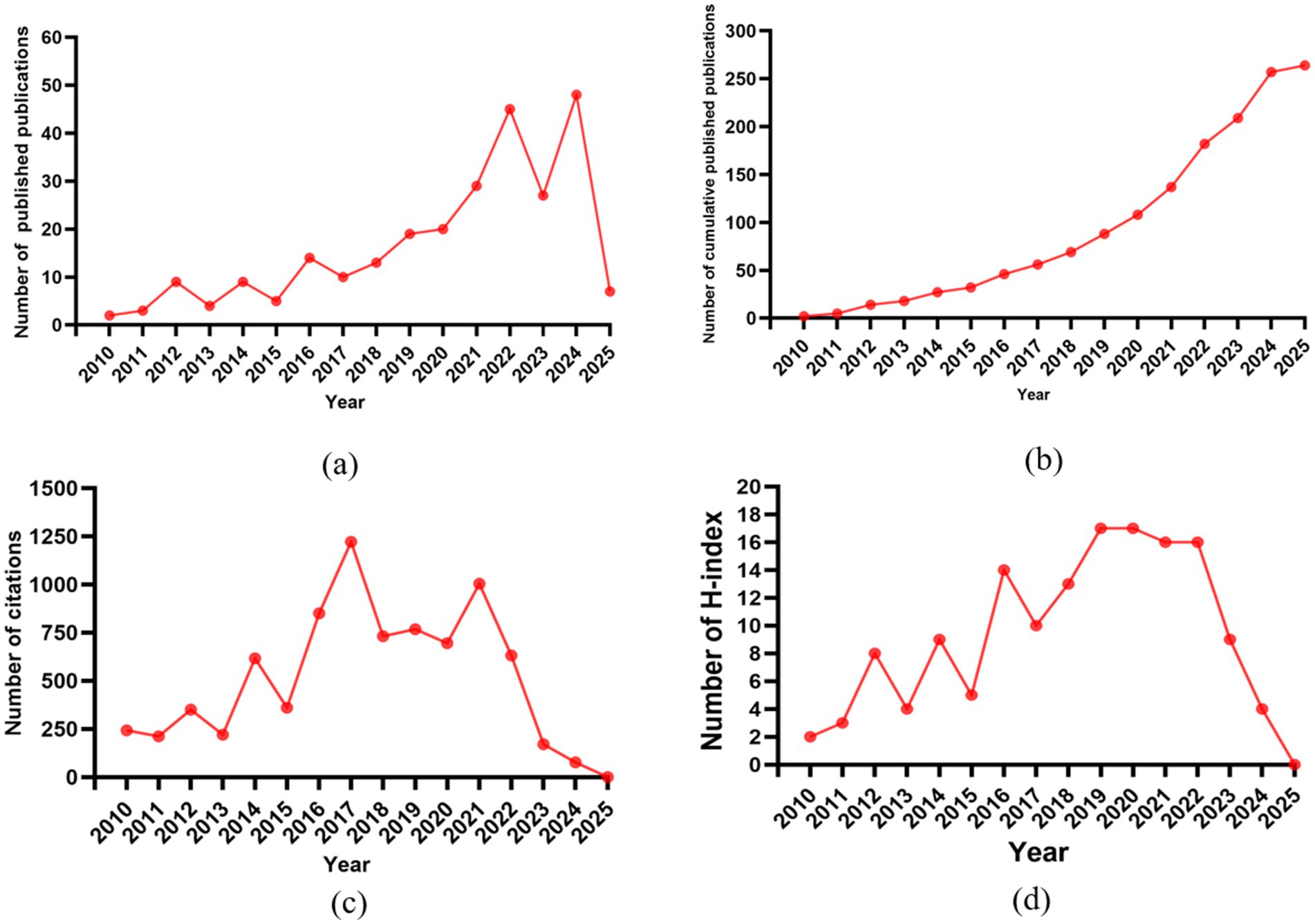
Figure 2. Overview of global annual publications. (a) The global annual number of publications. (b) The global annual number of cumulative publications. (c) The global annual number of citations of the publications. (d) The global annual H-index values of the publications.
3.3 Analysis of countries/regions and institutions attributes
A visualization map of the cooperation networks in each country is shown in Figure 3. A total of 51 countries/regions and 477 collaborations are shown. China has the strongest international collaboration network (TLS = 1,257) and the closest collaboration with the United States (LS = 114). We then analyze the number of publications, total citations, average citations and H-index for the 10 most productive countries. As shown in Table 1, China has the highest number of publications (95, 35.98%), followed by Russia (26, 9.85%) and the United States (23, 8.71%). China also has the highest number of citations (2686) and the highest H-index (33). The network map of institutional collaborations is shown in Figure 4, which includes 459 institutions and 13,867 collaborations. The State Research Center for Applied Microbiology and Biotechnology has the largest collaboration network (TLS = 1,640), and the largest publications (20, 7.58%), followed by the Russian Academy of Sciences (18, 6.82%) and Tzu Chi University (17, 6.44%). The 10 most productive institutions are shown in Table 2. Tzu Chi University has the highest H-index (12). Katholieke Universiteit Leuven has the highest total number of citations (841) and the highest average number of citations per paper (76.45).
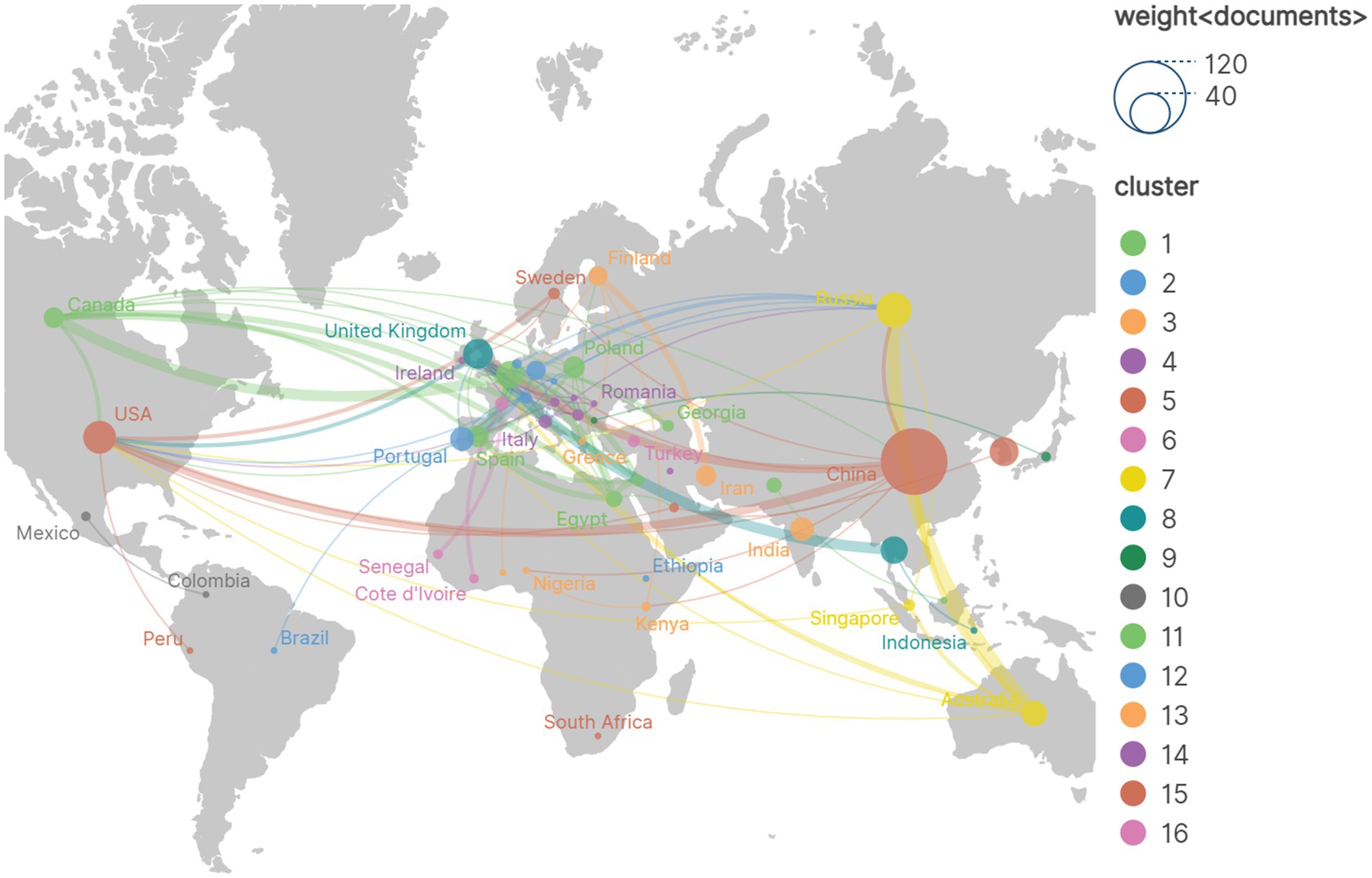
Figure 3. Visualization of collaboration among countries by a network map. The size of the nodes indicates the breadth of the co-operation, with thicker lines indicating a stronger relationship.
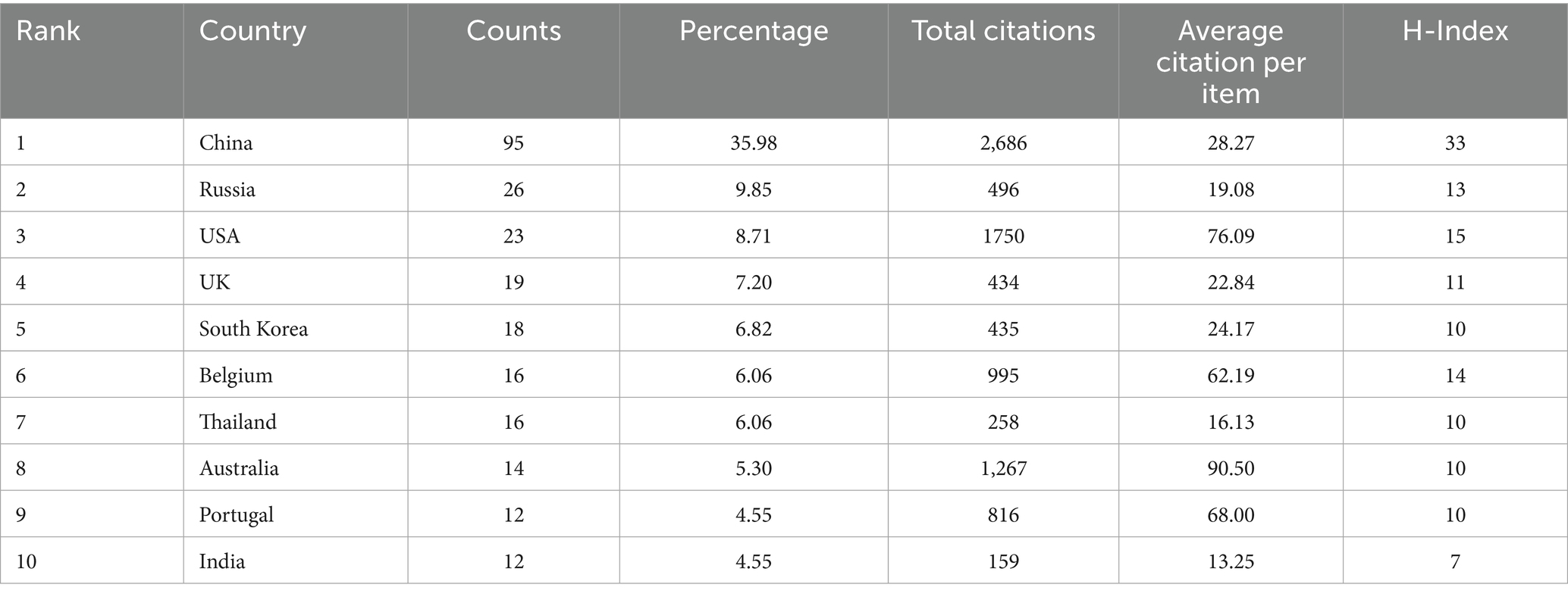
Table 1. The top 10 most productive countries regarding phages and A. baumannii research from 2010 to 2025.
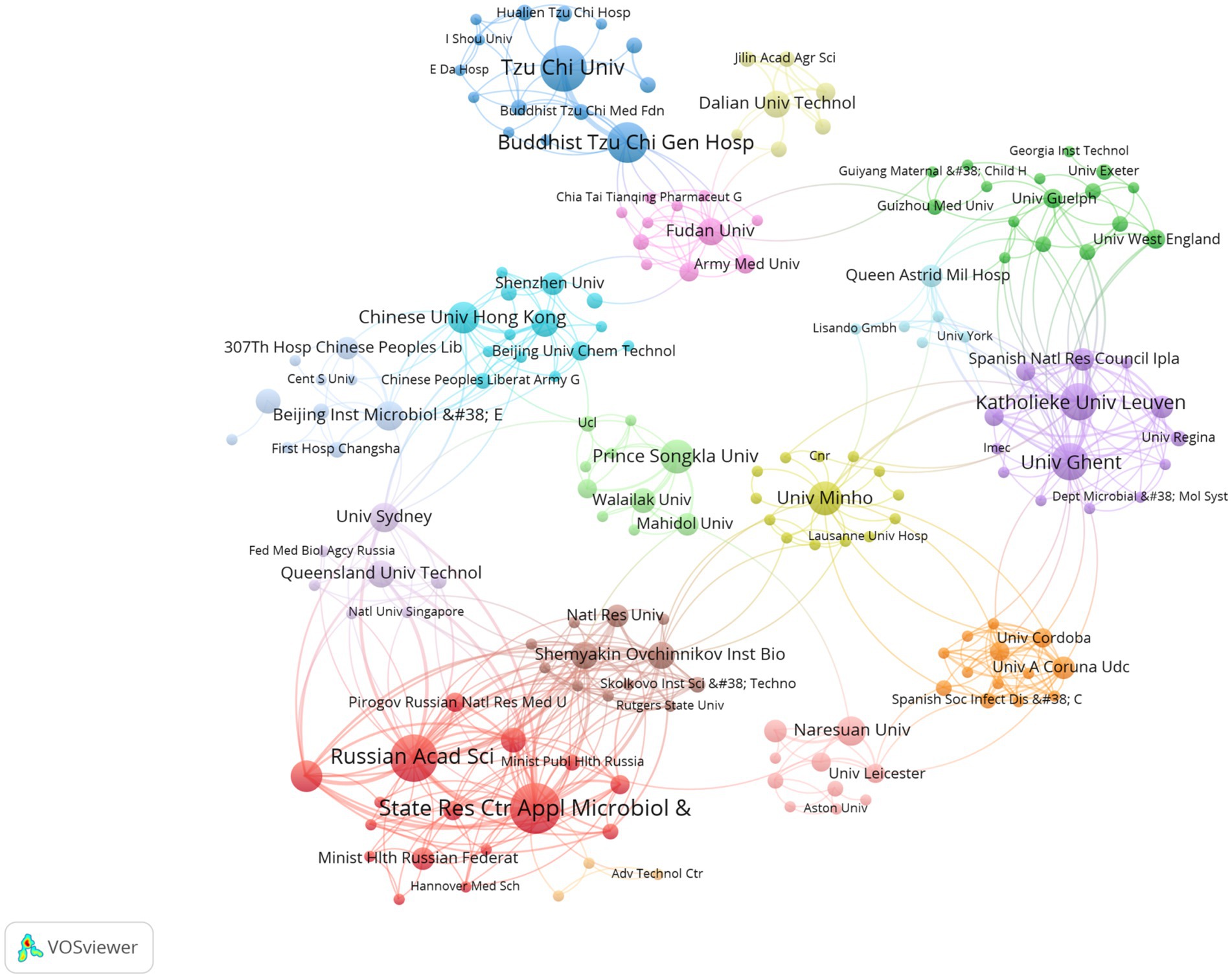
Figure 4. The co-authorship network map of institutions. The size of each institution’s node corresponds with its publication count. Line thickness illustrates levels of collaborative efforts among institutions in research of phages in A. baumannii infections.
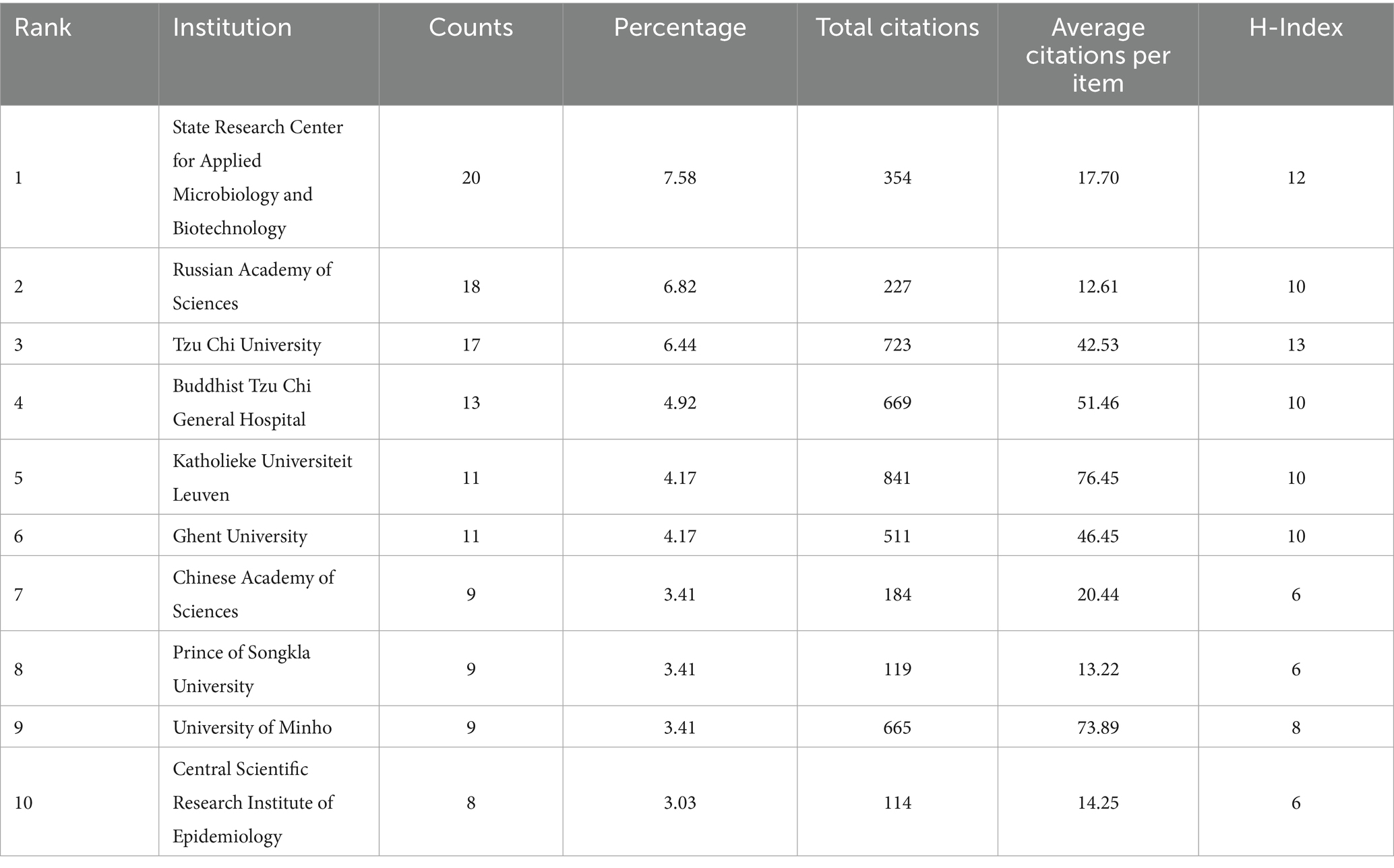
Table 2. The top 10 most productive institutions regarding phages and A. baumannii research from 2010 to 2025.
3.4 Analysis of authors of publications
A total of 1,503 authors were involved in all the publications analyzed. The top 10 authors with the highest number of publications are listed in Table 3. Shneider, Mikhail M. (Russia) has the highest number of publications in this field with 14 papers, followed by Knirel, Yuriy A. (Russia), Lin, Nien-Tsung (China) and Chen, Li-Kuang (China), who have all published 11 papers. Among these authors, Lin, Nien-Tsung has the highest H-index (10). In addition, Lavigne, Rob (Belgium) has the highest total number of citations and the average number of citations per paper. Shneider, Mikhail M. has the highest number of collaborations with other authors (total link strength TLS = 150). The author collaboration network diagram is shown in Figure 5. It can be found that there is strong collaboration within the teams, but fewer inter-team connections and insufficient cross-team collaboration. It is recommended to strengthen cross-team collaboration in the future to build a wider academic network.
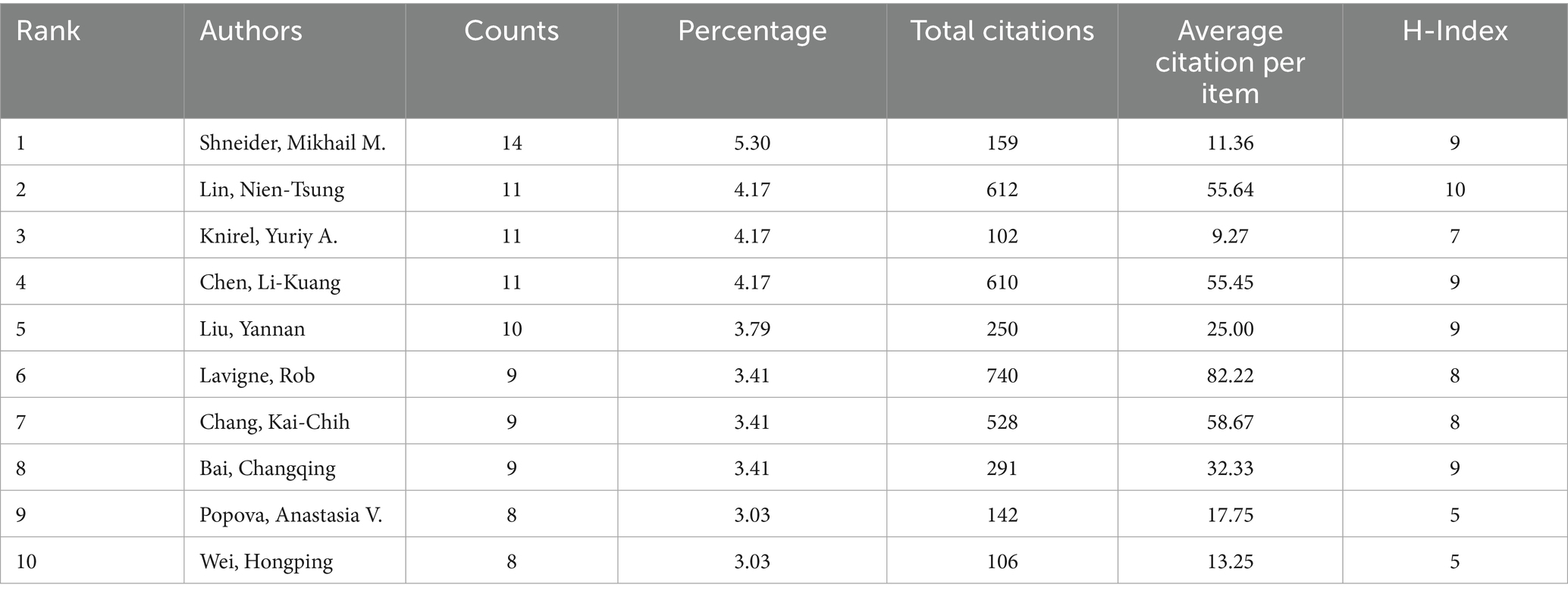
Table 3. The top 10 most productive authors regarding phages and A. baumannii research from 2010 to 2025.
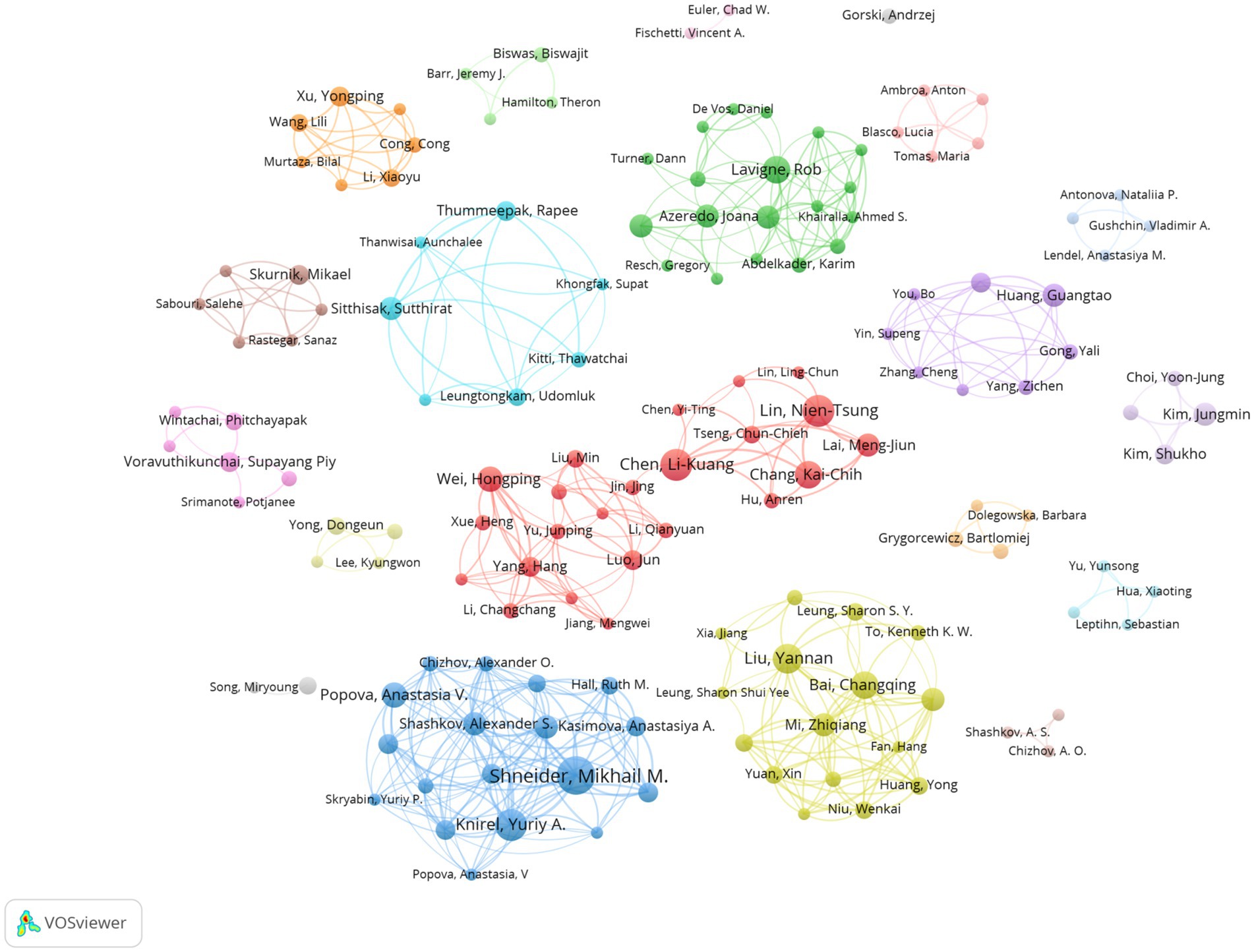
Figure 5. The co-authorship network map of authors. The size of each author’s node reflects their number of publications. Identical colours indicate the same cluster, and connecting lines between nodes represent collaborative links between authors.
3.5 Analysis of source journals
A total of 103 academic journals were active in the field of phage in A. baumannii infections. The top 10 journals published 116 articles (Table 4), accounting for 43.94% of all publications. Viruses-Basel, Frontiers in Microbiology and Archives of Virology were the top three journals publishing research in this area. Antimicrobial Agents and Chemotherapy had the highest number of citations and the highest average number of citations per article. Frontiers in Microbiology has the highest H-index (18), followed by Viruses-Basel (13). A network diagram of the most cited journals in this field is shown in Figure 6.
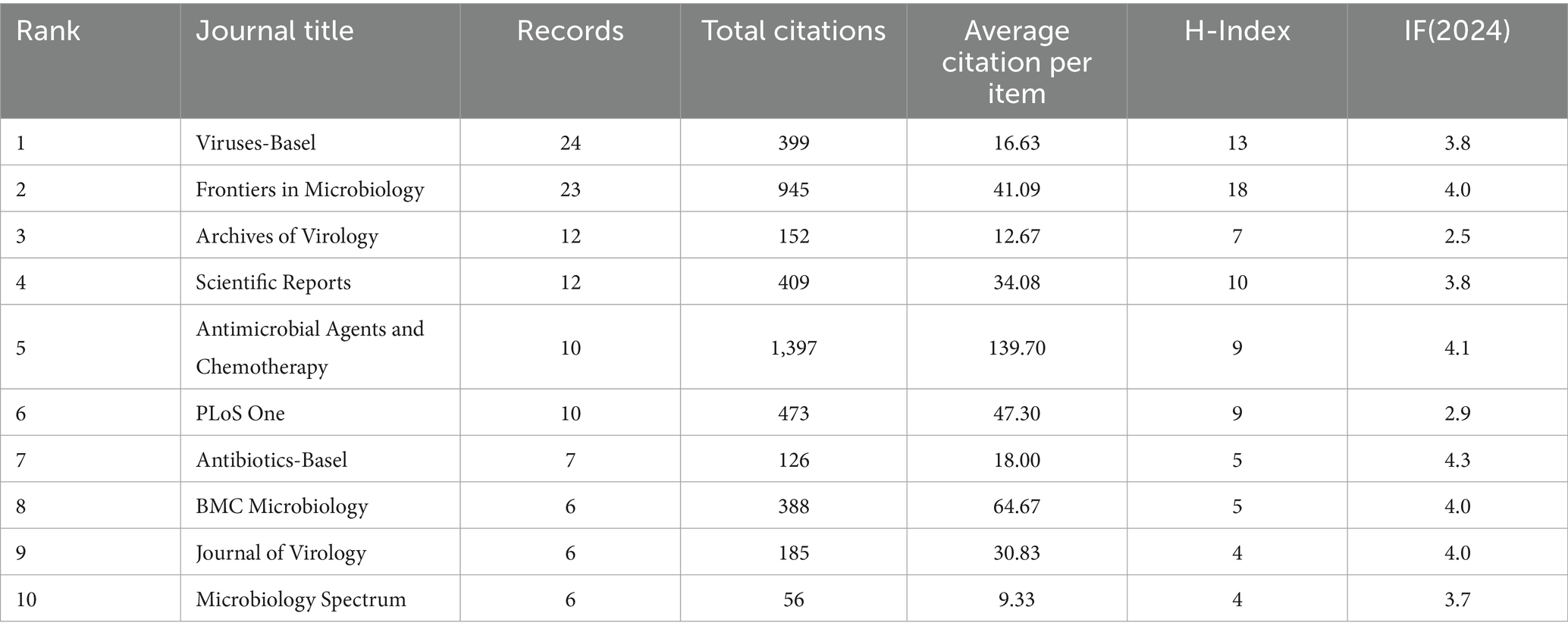
Table 4. The top 10 most productive journals regarding phages and A. baumannii research from 2010 to 2025.
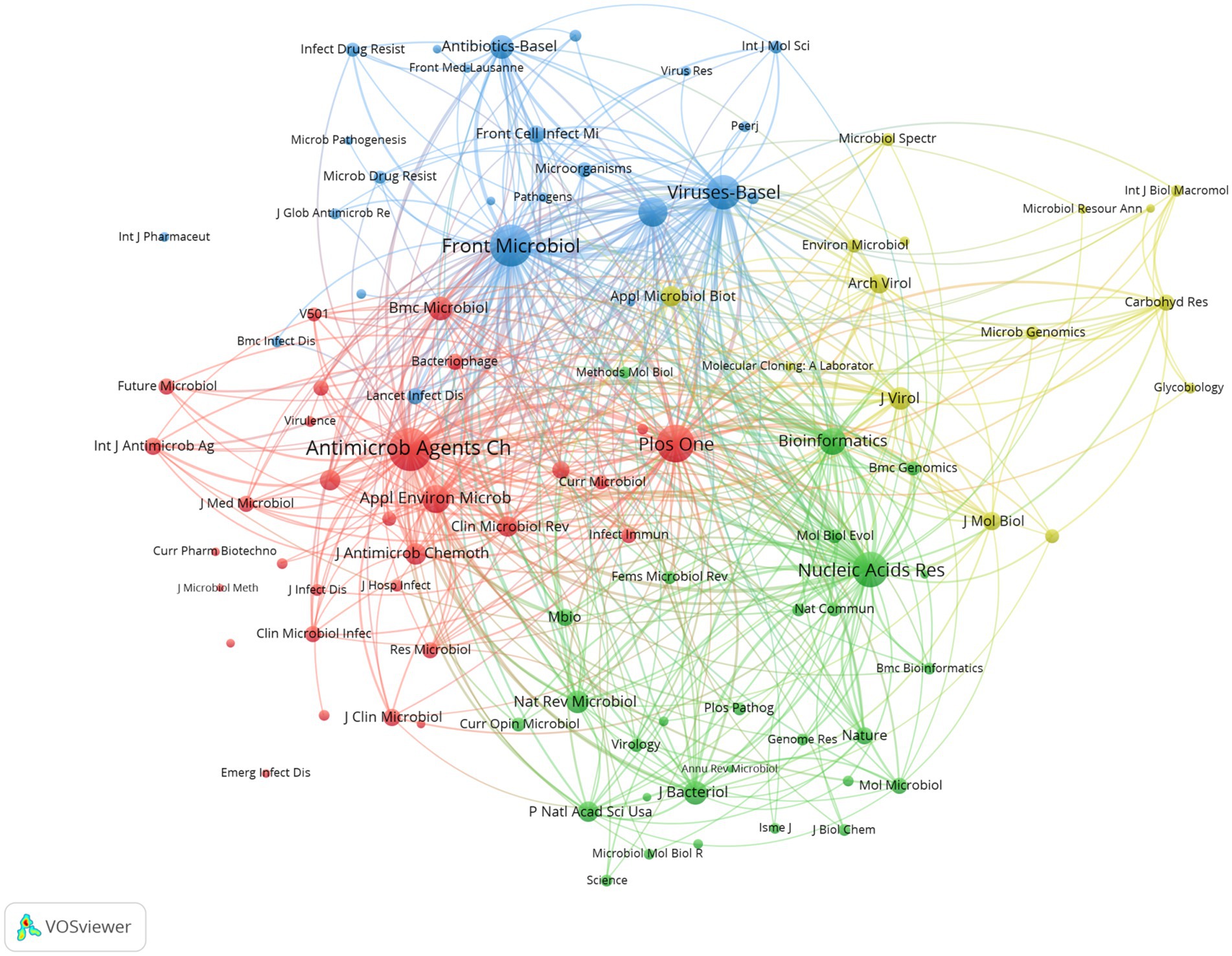
Figure 6. The co-authorship network map of journals. The size of each journal node reflects the journal’s activity. Identical colours indicate clustering in common subject areas, and the thickness of the connecting lines between nodes reflects the strength of co-authorship between journals.
In addition, the impact factor (IF) of a journal is an important parameter for assessing the value of the publications it contains (Wu H. et al., 2021). Among these, ACS Nano has the highest impact factor of 4.1, followed by Frontiers in Microbiology, BMC Microbiology and Journal of Virology, all of which have a current impact factor of 4.0. The top three most cited journals, in order, are Antimicrobial Agents and Chemotherapy (1,397 citations), Frontiers in Microbiology (945 citations) and PLoS One (473 citations).
3.6 Analysis of highly cited studies
The 10 most cited studies during the study period are shown in Table 5. Four of these studies were conducted independently by universities in China and Australia. The remaining 6 studies were from multi-institutional collaborations. Specifically, a study published in 2017 in Antimicrobial Agents and Chemotherapy entitled ‘Development and Use of Personalized Bacteriophage-Based Therapeutic Cocktails to Treat a Patient with a Disseminated Resistant Acinetobacter baumannii Infection’ was cited 792 times, making it the most cited publication in the field.
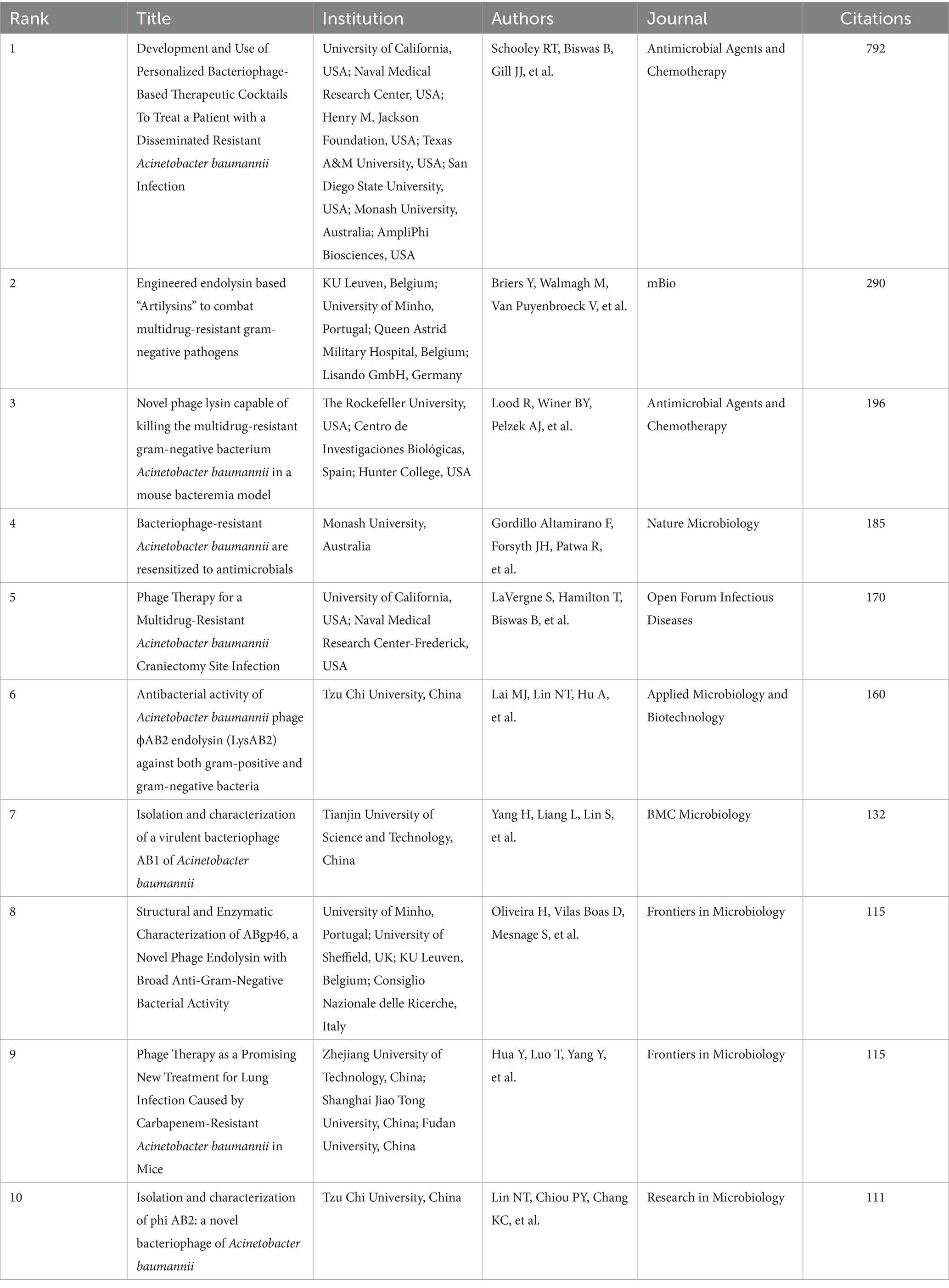
Table 5. The top 10 most productive studies regarding phages and A. baumannii research from 2010 to 2025.
3.7 Keyword analysis of research hotspots
Keyword co-occurrence analysis is a common method for identifying popular research topics. The network of co-occurring keywords is shown in Figure 7. The 15 most frequent keywords were phages A. baumannii phage therapy infections resistance endolysin gram negative bacteria therapy antimicrobial resistance mechanisms animal models biofilm multidrug resistance genes and antimicrobial. Figure 7 shows the keywords divided into 4 clusters. The first cluster in red is related to genomics and bioinformatics analysis and included keywords such as “bioinformatic analysis” “comparative genomic analyses” “genomic sequence” “prediction” and “identification.” The second group in green is related to the study of biological structure and antimicrobial activity included keywords such as “antibacterial activity” “biofilm formation” “endolysin” “lysins” and “enzymes.” The third group in blue is related to bacterial drug resistance and phage therapy research included keywords such as “antibiotic resistance” “multidrug resistance” “phage resistance” “phage therapy” “phage-antibiotic synergy” and “prophages.” The fourth group in yellow represents infection models and antimicrobial treatment strategies included keywords such as “animal models” “pneumonia model” “epidemiology” “cocktail” and “therapy.” As shown in Figure 8 terms marked in purple indicate that their average year of publication was 2019 or earlier while those marked in bright yellow appeared after 2022. Keywords such as “pathogens” “evolutionary analysis” “multidrug resistance” and “comparative genomic analyses” were the main topics during the early stage. The keywords “biofilm” “enzymes” “synergistic” and “mechanism” appeared relatively late in the study period
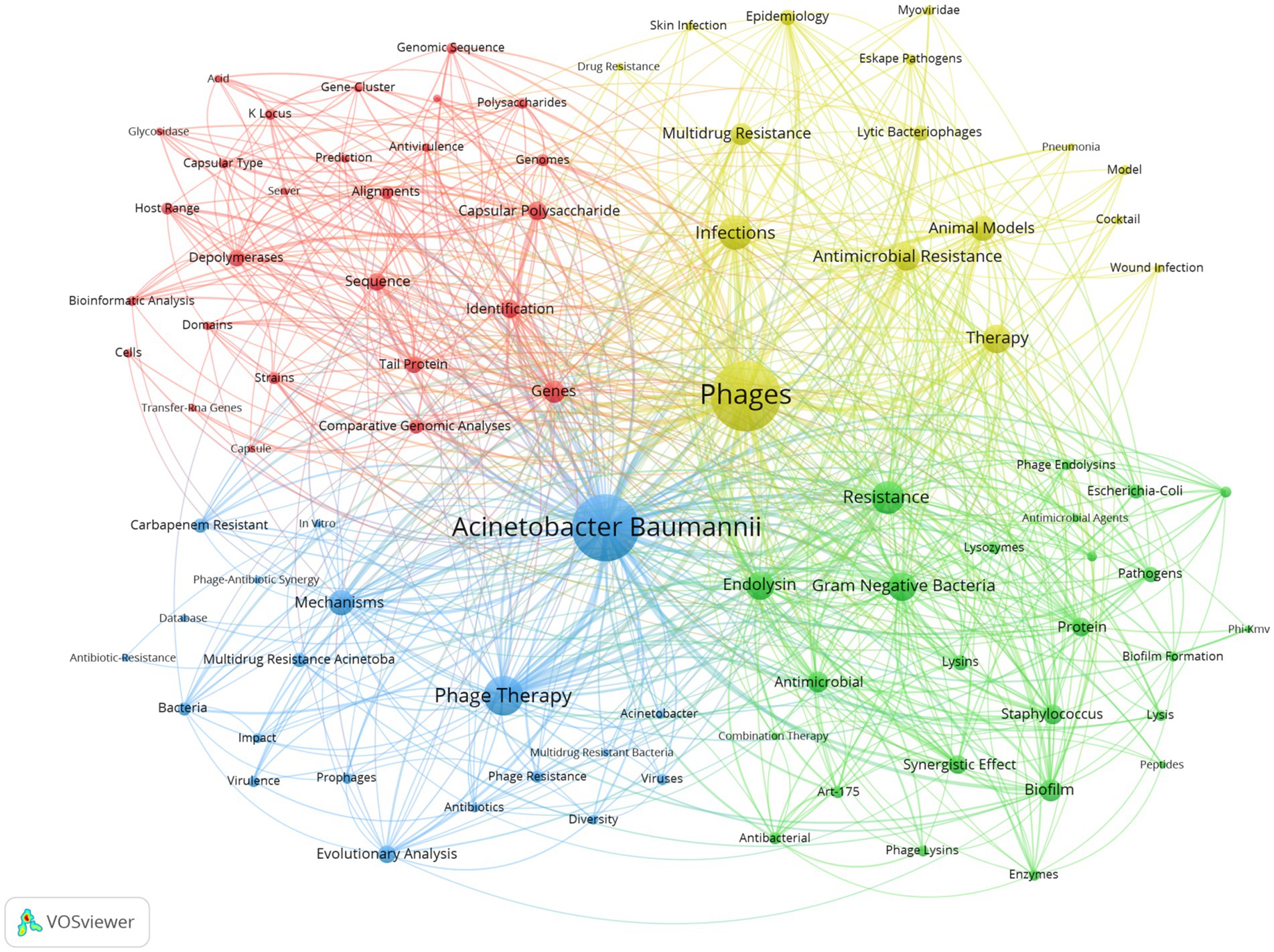
Figure 7. The network visualization of keywords Cooccurrence network. The size of each node indicates the size of the co-occurrence frequency of the corresponding keyword, the larger the node and font, the higher the frequency of occurrence. The thickness of the line between the nodes indicates the number of co-occurrences, and nodes of the same colour indicate the same cluster.
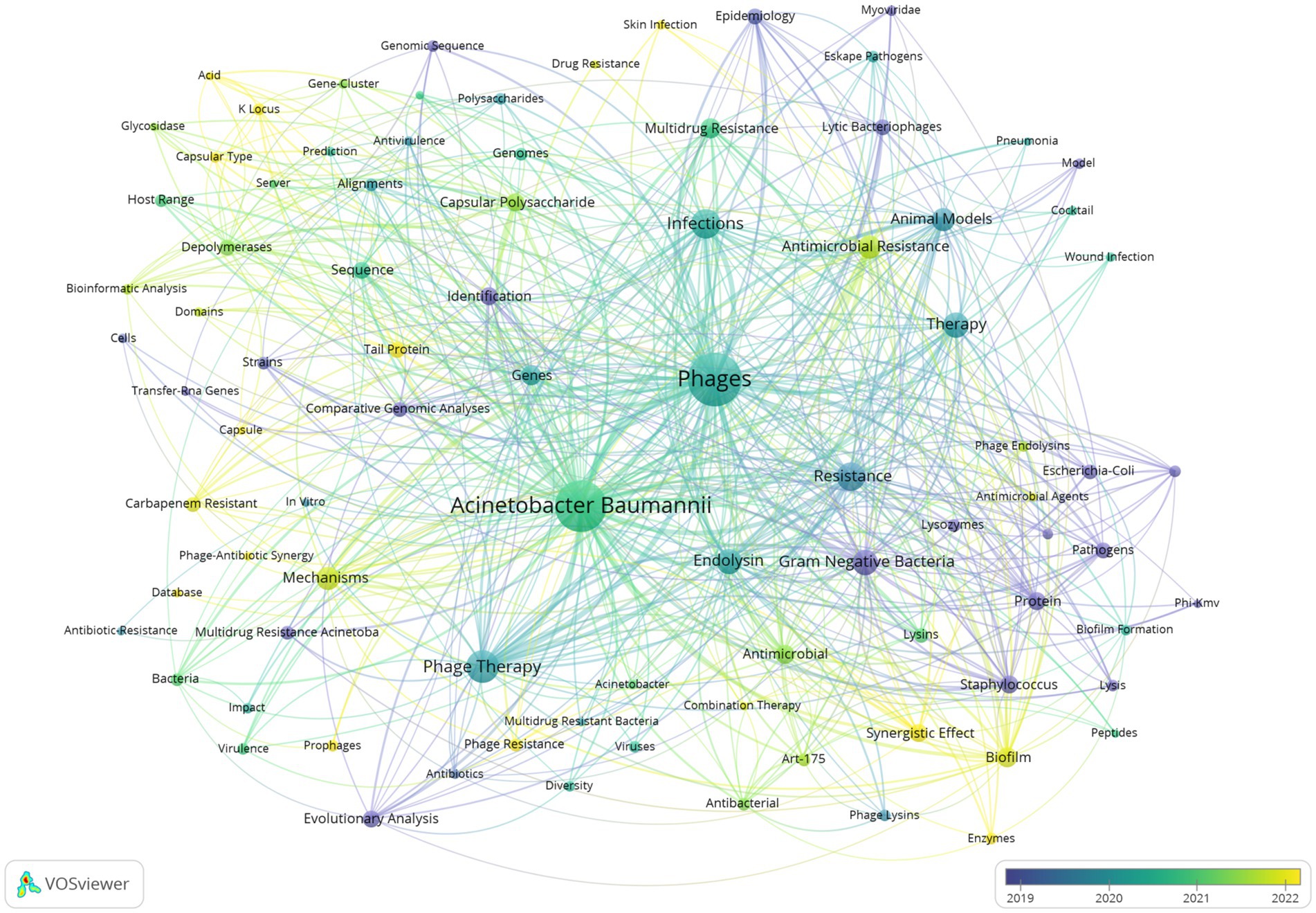
Figure 8. The overlay visualization of keywords Cooccurrence network. The overlay visualization shows the hotspots for phage applications in A. baumannii infections.
We used CiteSpace to show a visualization of the evolution of the keywords over time (Figure 9). In this figure, the Q value is 0.5202 and the S value is 0.831. Recent research has indicated that the issue of drug resistance has been a central focus, especially in relation to carbapenem-resistant A. baumannii and multidrug-resistant A. baumannii. The evolutionary trajectory of research keywords over the past decade or so has demonstrated this. Phage therapy has also been a popular research topic. In recent years, research has focused on analyzing biofilm properties, searching for sequence resistance genes, and exploring the molecular mechanisms of bacterial drug resistance through in vitro experiments and animal models. Concurrently, researchers are developing and applying novel antimicrobial strategies such as endolysin, cocktail therapy, and phage-antibiotic synergistic effect, as well as conducting evolutionary analysis. These research progresses show that phage is developing in the direction of multidisciplinary and multi-strategy in the study of A. baumannii infection.
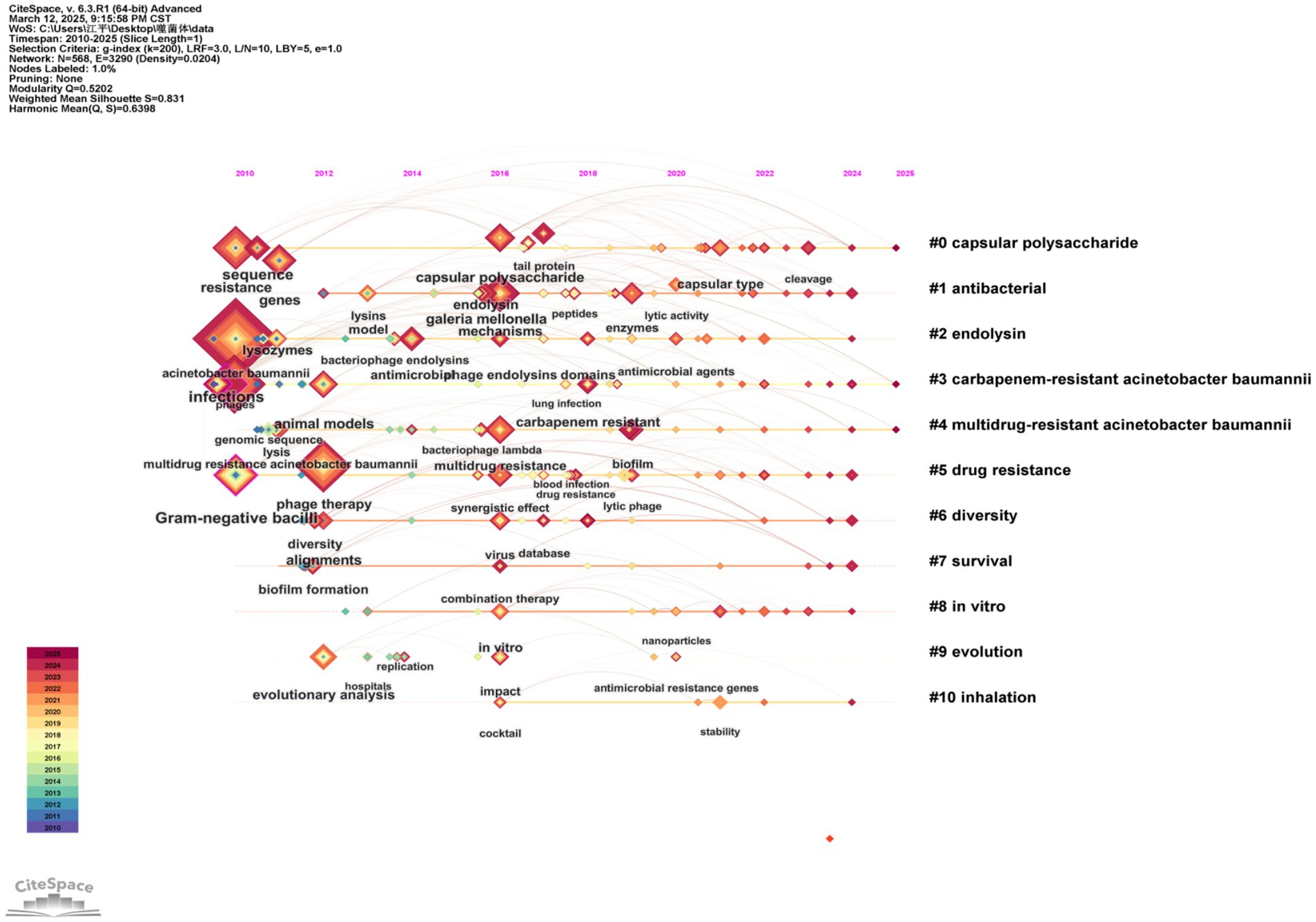
Figure 9. The timeline map of keywords cooccurrence. Each cluster is labelled according to the year it first appeared and different research topics are represented by colored lines.
Another important marker of research frontiers and hotspots throughout time is the intensity of the keyword bursts (Figure 10). Of the top 21 keywords with the strongest citation outbreaks, synergistic effect, which appeared in 2022, had the highest intensity of bursts (5.59), followed by therapeutic efficacy, which began in 2016 (3.69), and multidrug resistant bacteria, which started in 2010 (3.34). The different time periods of citation bursts for different keywords reflect the changes in research hotspots in the scientific community. The figure shows that the research hotspots have gradually shifted from “pathogens” and “genomic sequence” in the early stage to “synergistic effect”, “novel phage” and “antibiofilm activity” in the later stage. This shift may reflect the interest of the scientific community in emerging issues. It is noteworthy that the keywords “rapid adsorption,” “pathogens,” “genetic sequence,” “gram-negative bacteria,” “identification,” and “multidrug resistant bacteria” show continued research interest, indicating that these are still popular topics. In addition, based on the end years of the keyword citation bursts shown in the Figure 10, it can be predicted that the hotspots that will continue to receive attention in the next few years may be “phage resistance,” “synergistic effect” and “hospital-acquired infections.”
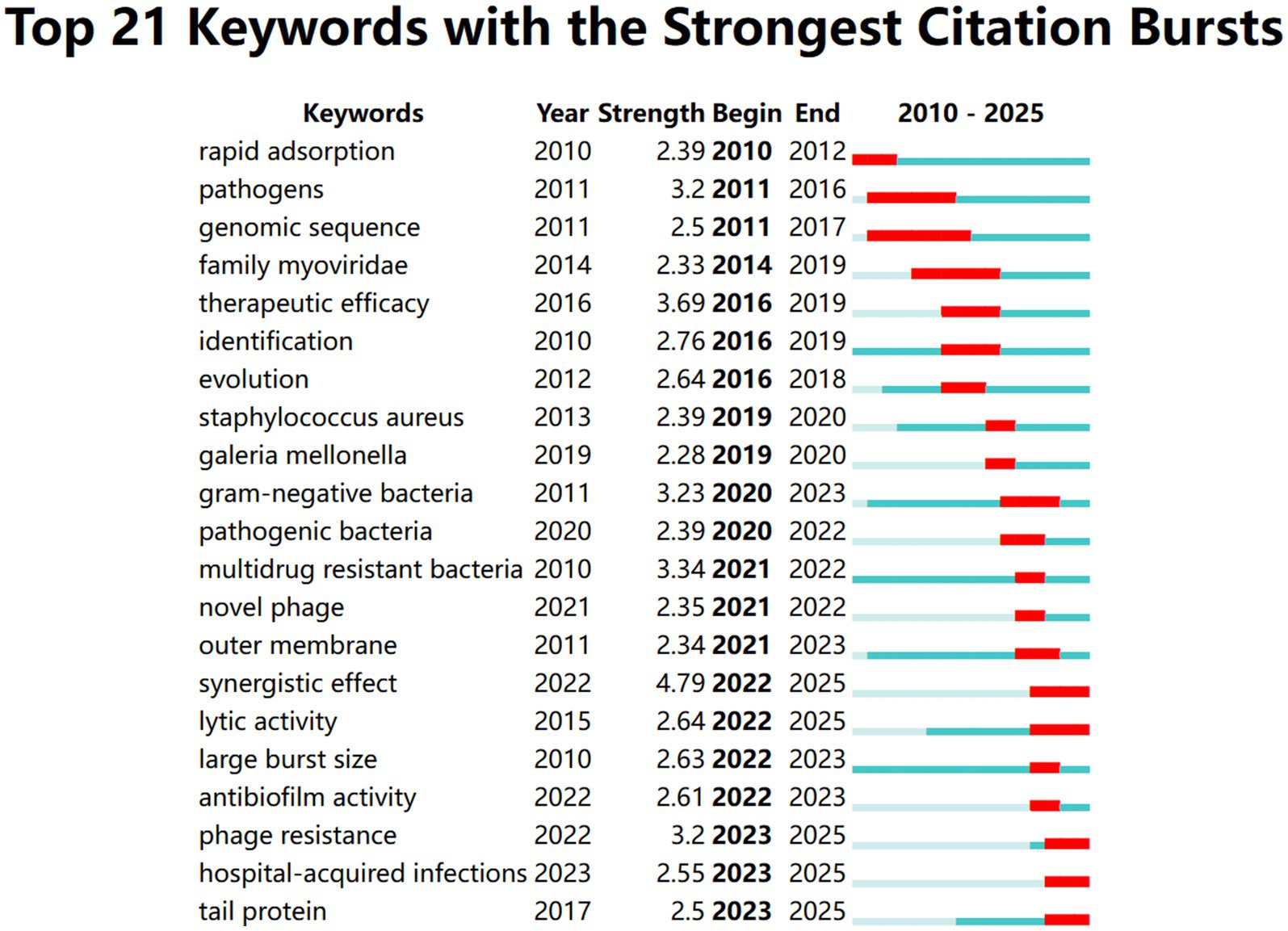
Figure 10. Top 21 keywords with the strongest citation bursts. A light blue line indicates a time period of frequency, a blue line indicates a time period of slightly higher frequency, and a red marker indicates a time period when the keyword’s frequency is in burst. ‘Strength’ indicates the intensity of the keyword’s citation burst, the higher the value, the higher the frequency of that time period.
4 Discussion
To the best of our knowledge, this is the first bibliometric analysis of the literature related to the use of phages in A. baumannii infections. Considering the sparse number of relevant studies prior to 2010, and the fact that these studies were scattered and spanned a wide range of time, even one of them lacked abstract, it was therefore not appropriate to include these studies in this review. Consequently, for the present study, 264 studies created between 1 January 2010 and 22 February 2025, that met the inclusion criteria were selected and analyzed by multiple software tools. This analysis generated tables and visual graphs to reveal the current state of research, popular research topics and cutting-edge trends in the field.
Overall, the number of annual publications in the field fluctuates back and forth, but the general trend is one of gradual increase. The number of publications peaks in 2024. The year 2019 was an important year for the field as it had the highest H-index and has remained high in subsequent years. We then analyzed the most influential countries, institutions, authors and journals in the field. China was found to be the leader in the field, with 3.65 times more publications than the second-ranked country, which is reflected in the fact that China has the highest number of international partnerships, publications, citations, and the highest H-index, with 4 of the 10 most cited studies coming from China. In addition, Tzu Chi University and Lin, Nien-Tsung are the most influential institutions and authors in this field in terms of H-index. In addition, Frontiers in Microbiology, Viruses-Basel, and Scientific Reports are considered to be the top three most influential journals in this field. Frontiers in Microbiology has the highest H-index, while Viruses-Basel has the highest number of publications. In terms of citations, Antimicrobial Agents and Chemotherapy has the highest total number of citations and the highest average number of citations per paper.
The reason for leading in research output, especially at the national level, in the case of China, the significant share of publication may also be related to the relevant policy promotion, in addition to the necessary resource input. In 2022, China’s National Health and Health Commission formulated the National Action Plan for Containment of Microbial Resistance (2022–2025), which is a follow-up to the implementation of the previous version of the plan (2016–2020) (Yuetian and Wenjuan, 2024), it can be affirmed that China has achieved some success in AMR, such as the 2023 version of the published Guidelines for the Diagnosis, Treatment, Prevention and Control of Carbapenem-Resistant Gram-Negative Bacterial Infections (Zeng et al., 2023), but the overall resistance situation is still not optimistic. 2022 China antimicrobial resistance surveillance system (CARSS) bacterial drug resistance surveillance report (Yuetian and Wenjuan, 2024) showed that the detection rate of CRAB was as high as 53.4%. In the same year, the Centers for Disease Control and Prevention (CDC, United States) published a report on the impact of novel coronavirus infections on AMR, which indicated a significant increase in the incidence of infections caused by healthcare-associated drug-resistant pathogens, with a 78% increase in the detection rate of Centers for Disease Control and Prevention (2023), therefore, it is imperative to strengthen the scientific research and cooperation on microbial resistance prevention and control in the world.
We then analyzed the top 10 most cited studies in the field. Highly cited studies are usually considered to be important and influential. One of the most cited publications reported a clinical case study of phage therapy for drug-resistant A. baumannii infections (Schooley et al., 2017), successfully applied personalized phage therapy to effectively eradicate drug-resistant A. baumannii infections by intravenous and local injection of a phage cocktail. Another similar clinical case study among these 10 studies (LaVergne et al., 2018), which reported the case of a patient with multidrug-resistant A. baumannii infections treated with intravenous phage therapy after craniectomy. Although the patient did not recover from the injury, phage therapy was well tolerated with no significant adverse effects. The therapeutic experience with phages is encouraging, good clinical outcomes have been observed and the safety profile appears to be positive, but there are still few clinical trials of phage therapy for A. baumannii infections. There is clearly an urgent need for more clinical trials to confirm the value of phage therapy on the basis of evidence-based medicine.
In addition, 4 studies characterized the antimicrobial properties of different phages. One of them (Gordillo Altamirano et al., 2021) characterized phages ΦFG02 and ΦCO01. To exert their antimicrobial effects by targeting the capsule of A. baumannii, and the resistant mutant strains were re-susceptible to various antimicrobial agents due to the absence of the capsule, and the phage therapies showed significant antimicrobial effects in a mouse model. Researchers in another study (Yang et al., 2010) isolated and characterized the phage AB1, a potent phage of A. baumannii, which exhibited rapid growth and high pH stability and high thermal stability. The third study (Lin et al., 2010) characterized the virulent A. baumannii phage fAB2 isolated from hospital wastewater for the first time. fAB2 possessed broad-spectrum lysogenic activity against multidrug-resistant A. baumannii with the advantages of rapid adsorption, short latency and high lysogenicity. And the authors in last one study (Hua et al., 2017) isolated a phage, SH-Ab15519, showed good therapeutic efficacy against carbapenem-resistant A. baumannii lung infection in a mouse model, significantly improving the survival rate of the mice without obvious side effects.
Three other studies characterized the antimicrobial properties of different endolysins (lysins). Lysins are phage-encoded enzymes that degrade the bacterial cell wall at the end of the phage replication cycle, releasing newly assembled phages. They are not as specific as phages, and a single phage-encoded endolysin may be able to lysate a wide range of bacteria. One study (Lood et al., 2015) identified the novel endolysin PlyF307 showed strong bactericidal activity against multidrug-resistant A. baumannii, which not only efficiently cleared planktonic bacteria and biofilm in vitro, but also improved the survival rate of infected mice in a mouse bacteraemia model. One study (Lai et al., 2011) isolated endolysins LysAB2 from A. baumannii phage 6AB2, which exhibited broad-spectrum antibacterial activity against a variety of drug-resistant bacteria, including A. baumannii, by enhancing the permeability of bacterial cell membranes, and possessed good thermal stability. The other study (Oliveira et al., 2016) identified the novel endolysins ABgp46 from the A. baumannii phage vb_AbaP_CEB1 as having a broad-spectrum of antimicrobial activity against drug-resistant Gram-negative bacteria, and the antimicrobial effect was significantly enhanced when combined with citric and malic acids.
In the last study (Briers et al., 2014), artilysins developed through protein engineering successfully breached the outer membrane barrier of Gram-negative bacteria, including A. baumannii, and demonstrated effective bactericidal activity against drug-resistant strains. As we know, the popularity and application of sequencing technology has enabled researchers to discover many new phages (Blasco et al., 2022; Kyriakidis et al., 2021). Further analysis of the unknown functional proteins of A. baumannii phages will facilitate the development of phage-derived enzyme preparations. While second-generation sequencing and gene editing technologies have accelerated the screening and engineering of phages. There is still great potential in this field, despite the limited research on engineered phages that effectively degrade multidrug-resistant A. baumannii (Popova et al., 2019; Shchurova et al., 2021; Vukotic et al., 2020).
It is worth noting that “biofilm” is also one of the high-frequency keywords. Biofilms are composed of bacterial communities encapsulated in a fibrin matrix that impedes antibiotic penetration and enhances environmental adaptation (Leptihn and Loh, 2022). In recent years, the ability to form biofilms has been identified as a central factor in drug resistance and nosocomial infection outbreaks in A. baumannii. It has been shown that phage action on biofilms can disrupt the biofilm matrix, expose bacterial surface receptors and initiate the infection cycle with enhanced antibiotic penetration, resulting in a synergistic bactericidal effect (Hernandez-Morales et al., 2018). Therefore, the study of phages acting on biofilms is particularly necessary. As phages continue to be discovered and characterized to lyse biofilm-associated proteins, many studies have reported the effective elimination of A. baumannii using phage haemolysins or depolymerases (Huang et al., 2014; Oliveira et al., 2016), and although such proteins are unable to replicate themselves, the lower risk of resistance and the significant effect of combination with antibiotics provide new ideas for clinical treatment.
Specifically, phages can specifically lyse CRAB that are ineffective for antibiotics and are suitable for critical infections (Schooley et al., 2017). In addition, by combining with antibiotics, phages can simultaneously improve antibiotic penetration and reduce the occurrence of drug resistance when disrupting biofilms, and the synergistic effect of the two to enhance efficacy can break through biofilm-associated infections (Chan et al., 2016) The bactericidal mechanism of lytic enzymes secreted by phage is different from that of phage itself and antibiotics, and phage enzymes can dissolve more pathogenic bacteria and do not generate resistance, and phage enzyme-related agents may be widely used for biocontrol in the future (Coleman et al., 2012; Lu and Collins, 2007). Phage cocktail therapy, on the other hand, involves screening of matching phages based on strains isolated from patients to achieve personalized treatment and reduce the risk of drug resistance through phage combination therapy (Merabishvili et al., 2014).
However, phage therapy still faces several challenges. These include the limited spectrum of phage lysis and the development of bacterial resistance through rapid mutation of phage receptors (Wang et al., 2023). However, it is encouraging to note that phage cocktail therapy or phage combination therapy may be an effective response strategy. Phage cocktails have been identified as the best solution for clinical applications, but more cocktail combination therapies still need to be explored to identify the most effective cocktails and further elucidate the combination mechanisms (Caflisch et al., 2019; Cui et al., 2019; Grygorcewicz et al., 2021; Luong et al., 2020a). Combinations of phage and other antimicrobial substances are also promising for the treatment of A. baumannii, including phage-antibiotic combination therapies (Grygorcewicz et al., 2020), phage-natural antimicrobial combination therapies (Wintachai and Voravuthikunchai, 2022), and even phage-photosensitizer combination (Ran et al., 2020). However, further experimental studies are needed to determine the optimal combination regimen and application strategy (Gordillo Altamirano et al., 2022; Grygorcewicz et al., 2021).
More seriously, the high host specificity of phages makes it challenging to prepare phage cocktails in advance, and current cocktail therapies still require the implementation of highly individualized regimens, which leads to high investment in screening specific phages and subsequent treatment (Mattila et al., 2015). In addition, because of the widespread lack of a theoretical mechanism system for phage therapy, the current lack of authoritative guidelines or consensus on clinical application, and the possible risk of endotoxin release in the treatment of Gram-negative drug-resistant bacteria, many patients do not agree to be treated with phages. This is one of the major reasons why phage therapy has not been approved as clinical drug therapy (Knoll and Mylonakis, 2014; Schooley et al., 2017).
The rapid emergence of bacterial resistance to phages makes the application of phage therapy crucial. Therefore, there is a need for basic research, including the characterization of phage host receptors and the molecular mechanism of phage resistance in A. baumannii. In the future, phage therapy needs to promote the establishment of a global phage resource sharing platform based on the analysis of bacterial phage interaction mechanisms. Through the integration of precise targeting, synergistic antimicrobial agents and technological innovation, phage therapy is expected to break the multidrug resistance dilemma and open a new avenue for anti-infection treatment.
This study also has some limitations. Firstly, the literature was only retrieved from the WOSCC database, which may have resulted in an incomplete search. However, this database is one of the largest and most comprehensive databases in the world and is the most commonly used source of literature in bibliometric analyses, and the size of its data is sufficient to reflect the current state of research in the field. Secondly, we only selected studies published in English. Finally, some citation metrics in bibliometric analyses may be somewhat biased because citations are affected by various factors, such as time windows, self citation, author authority, journal impact and open access status (Urlings et al., 2021). For example, because of the lag in citations, the number of cited studies in recent years is relatively small.
5 Conclusion
In summary, we performed bibliometric analyses using various statistical software to obtain an overview on phages in A. baumannii infections. We enumerate the characteristics of publications, show the most influential countries, institutions, authors, and journals, and visual the research hotspots in the field of phage therapy along with their application for the prevention and treatment of A. baumannii infections. In addition, we discuss the advantages and challenges faced by phages in the control of A. baumannii infections. Phage therapy can be a powerful tool for the treatment of A. baumannii infections.
Data availability statement
The original contributions presented in the study are included in the article/Supplementary material, further inquiries can be directed to the corresponding author/s.
Author contributions
PJ: Visualization, Conceptualization, Validation, Methodology, Data curation, Writing – review & editing, Writing – original draft, Software, Formal analysis. XL: Validation, Writing – review & editing, Resources, Formal analysis, Writing – original draft, Investigation. JZ: Software, Writing – review & editing, Supervision, Validation. JS: Writing – review & editing, Investigation, Resources, Validation. ZS: Writing – review & editing, Software, Supervision, Project administration. PC: Project administration, Writing – review & editing, Supervision, Conceptualization, Funding acquisition.
Funding
The author(s) declare that no financial support was received for the research and/or publication of this article.
Acknowledgments
We would like to express our sincere gratitude to all the authors whose excellent studies were included in this article. We appreciate their valuable contributions to this field and their willingness to share their data and insights.
Conflict of interest
The authors declare that the research was conducted in the absence of any commercial or financial relationships that could be construed as a potential conflict of interest.
Generative AI statement
The authors declare that no Gen AI was used in the creation of this manuscript.
Publisher’s note
All claims expressed in this article are solely those of the authors and do not necessarily represent those of their affiliated organizations, or those of the publisher, the editors and the reviewers. Any product that may be evaluated in this article, or claim that may be made by its manufacturer, is not guaranteed or endorsed by the publisher.
Supplementary material
The Supplementary material for this article can be found online at: https://www.frontiersin.org/articles/10.3389/fmicb.2025.1606351/full#supplementary-material
References
Abedon, S. T., Kuhl, S. J., Blasdel, B. G., and Kutter, E. M. (2011). Phage treatment of human infections. Bacteriophage 1, 66–85. doi: 10.4161/bact.1.2.15845
Antimicrobial Resistance Collaborators (2022). Global burden of bacterial antimicrobial resistance in 2019: a systematic analysis. Lancet 399, 629–655. doi: 10.1016/S0140-6736(21)02724-0
Antunes, L. C., Visca, P., and Towner, K. J. (2014). Acinetobacter baumannii: evolution of a global pathogen. Pathog. Dis. 71, 292–301. doi: 10.1111/2049-632X.12125
Blasco, L., Bleriot, I., Gonzalez De Aledo, M., Fernandez-Garcia, L., Pacios, O., Oliveira, H., et al. (2022). Development of an anti-Acinetobacter baumannii biofilm phage cocktail: genomic adaptation to the host. Antimicrob. Agents Chemother. 66:e0192321. doi: 10.1128/AAC.01923-21
Briers, Y., Walmagh, M., Van Puyenbroeck, V., Cornelissen, A., Cenens, W., Aertsen, A., et al. (2014). Engineered endolysin-based "artilysins" to combat multidrug-resistant gram-negative pathogens. MBio 5, e01379–e01314. doi: 10.1128/mBio.01379-14
Caflisch, K. M., Suh, G. A., and Patel, R. (2019). Biological challenges of phage therapy and proposed solutions: a literature review. Expert Rev. Anti-Infect. Ther. 17, 1011–1041. doi: 10.1080/14787210.2019.1694905
Centers for Disease Control and Prevention (2023). Antibiotic resistance threats in the United. States, 2019. Atlanta, GA: Centers for Disease Control and Prevention.
Cha, K., Oh, H. K., Jang, J. Y., Jo, Y., Kim, W. K., Ha, G. U., et al. (2018). Characterization of two novel bacteriophages infecting multidrug-resistant (MDR) Acinetobacter baumannii and evaluation of their therapeutic efficacy in vivo. Front. Microbiol. 9:696. doi: 10.3389/fmicb.2018.00696
Chan, B. K., Sistrom, M., Wertz, J. E., Kortright, K. E., Narayan, D., and Turner, P. E. (2016). Phage selection restores antibiotic sensitivity in MDR pseudomonas aeruginosa. Sci. Rep. 6:26717. doi: 10.1038/srep26717
Chang, R., Morales, S., Okamoto, Y., and Chan, H. K. (2020). Topical application of bacteriophages for treatment of wound infections. Transl. Res. 220, 153–166. doi: 10.1016/j.trsl.2020.03.010
Chang, R., Nang, S. C., Chan, H. K., and Li, J. (2022). Novel antimicrobial agents for combating antibiotic-resistant bacteria. Adv. Drug Deliv. Rev. 187:114378. doi: 10.1016/j.addr.2022.114378
Chang, R., Wallin, M., Lin, Y., Leung, S., Wang, H., Morales, S., et al. (2018). Phage therapy for respiratory infections. Adv. Drug Deliv. Rev. 133, 76–86. doi: 10.1016/j.addr.2018.08.001
Chang, R. Y., Wong, J., Mathai, A., Morales, S., Kutter, E., Britton, W., et al. (2017). Production of highly stable spray dried phage formulations for treatment of pseudomonas aeruginosa lung infection. Eur. J. Pharm. Biopharm. 121, 1–13. doi: 10.1016/j.ejpb.2017.09.002
Chen, X., Liu, M., Zhang, P., Xu, M., Yuan, W., Bian, L., et al. (2022). Phage-derived depolymerase as an antibiotic adjuvant against multidrug-resistant Acinetobacter baumannii. Front. Microbiol. 13:845500. doi: 10.3389/fmicb.2022.845500
Chu, J., Poh, W. H., Hasnuddin, N., Hew, E. Y., Dam, L. C., Sahili, A. E., et al. (2022). Novel phage lysin abp013 against Acinetobacter baumannii. Antibiotics (Basel) 11:169. doi: 10.3390/antibiotics11020169
Clokie, M. R., Millard, A. D., Letarov, A. V., and Heaphy, S. (2011). Phages in nature. Bacteriophage 1, 31–45. doi: 10.4161/bact.1.1.14942
Coleman, C. I., Limone, B., Sobieraj, D. M., Lee, S., Roberts, M. S., Kaur, R., et al. (2012). Dosing frequency and medication adherence in chronic disease. J. Manag. Care Pharm. 18, 527–539. doi: 10.18553/jmcp.2012.18.7.527
Cui, Z., Guo, X., Feng, T., and Li, L. (2019). Exploring the whole standard operating procedure for phage therapy in clinical practice. J. Transl. Med. 17:373. doi: 10.1186/s12967-019-2120-z
Gazzaz, Z. J., Butt, N. S., Zubairi, N. A., and Malik, A. A. (2020). Scientometric evaluation of research productivity on diabetes from the Kingdom of Saudi Arabia over the last two decades (2000-2019). J. Diabetes Res. 2020:1514282. doi: 10.1155/2020/1514282
Gordillo Altamirano, F., Forsyth, J. H., Patwa, R., Kostoulias, X., Trim, M., Subedi, D., et al. (2021). Bacteriophage-resistant Acinetobacter baumannii are resensitized to antimicrobials. Nat. Microbiol. 6, 157–161. doi: 10.1038/s41564-020-00830-7
Gordillo Altamirano, F. L., Kostoulias, X., Subedi, D., Korneev, D., Peleg, A. Y., and Barr, J. J. (2022). Phage-antibiotic combination is a superior treatment against Acinetobacter baumannii in a preclinical study. EBioMedicine 80:104045. doi: 10.1016/j.ebiom.2022.104045
Grygorcewicz, B., Roszak, M., Golec, P., Śleboda-Taront, D., Łubowska, N., Górska, M., et al. (2020). Antibiotics act with vb_AbaP_AGC01 phage against Acinetobacter baumannii in human heat-inactivated plasma blood and Galleria mellonella models. Int. J. Mol. Sci. 21:4390. doi: 10.3390/ijms21124390
Grygorcewicz, B., Wojciuk, B., Roszak, M., Łubowska, N., Błażejczak, P., Jursa-Kulesza, J., et al. (2021). Environmental phage-based cocktail and antibiotic combination effects on Acinetobacter baumannii biofilm in a human urine model. Microb. Drug Resist. 27, 25–35. doi: 10.1089/mdr.2020.0083
Hernandez-Morales, A. C., Lessor, L. L., Wood, T. L., Migl, D., Mijalis, E. M., Cahill, J., et al. (2018). Genomic and biochemical characterization of acinetobacter podophage petty reveals a novel lysis mechanism and tail-associated depolymerase activity. J. Virol. 92:e01064-17. doi: 10.1128/JVI.01064-17
Hibstu, Z., Belew, H., Akelew, Y., and Mengist, H. M. (2022). Phage therapy: a different approach to fight bacterial infections. Biologics 16, 173–186. doi: 10.2147/BTT.S381237
Hua, Y., Luo, T., Yang, Y., Dong, D., Wang, R., Wang, Y., et al. (2017). Phage therapy as a promising new treatment for lung infection caused by carbapenem-resistant Acinetobacter baumannii in mice. Front. Microbiol. 8:2659. doi: 10.3389/fmicb.2017.02659
Huang, G., Shen, X., Gong, Y., Dong, Z., Zhao, X., Shen, W., et al. (2014). Antibacterial properties of Acinetobacter baumannii phage abp1 endolysin (PlyAB1). BMC Infect. Dis. 14:681. doi: 10.1186/s12879-014-0681-2
Jasim, H. N., Hafidh, R. R., and Abdulamir, A. S. (2018). Formation of therapeutic phage cocktail and endolysin to highly multi-drug resistant Acinetobacter baumannii: in vitro and in vivo study. Iran. J. Basic Med. Sci. 21, 1100–1108. doi: 10.22038/IJBMS.2018.27307.6665
Knoll, B. M., and Mylonakis, E. (2014). Antibacterial bioagents based on principles of bacteriophage biology: an overview. Clin. Infect. Dis. 58, 528–534. doi: 10.1093/cid/cit771
Kyriakidis, I., Vasileiou, E., Pana, Z. D., and Tragiannidis, A. (2021). Acinetobacter baumannii antibiotic resistance mechanisms. Pathogens 10:373. doi: 10.3390/pathogens10030373
Lai, M., Lin, N., Hu, A., Soo, P., Chen, L., Chen, L., et al. (2011). Antibacterial activity of acinetobacter baumannii phage varphiAB2 endolysin (LysAB2) against both gram-positive and gram-negative bacteria. Appl. Microbiol. Biotechnol. 90, 529–539. doi: 10.1007/s00253-011-3104-y
LaVergne, S., Hamilton, T., Biswas, B., Kumaraswamy, M., Schooley, R. T., and Wooten, D. (2018). Phage therapy for a multidrug-resistant Acinetobacter baumannii craniectomy site infection. Open Forum Infect. Dis. 5:ofy064. doi: 10.1093/ofid/ofy064
Leptihn, S., and Loh, B. (2022). Complexity, challenges and costs of implementing phage therapy. Future Microbiol. 17, 643–646. doi: 10.2217/fmb-2022-0054
Leshkasheli, L., Kutateladze, M., Balarjishvili, N., Bolkvadze, D., Save, J., Oechslin, F., et al. (2019). Efficacy of newly isolated and highly potent bacteriophages in a mouse model of extensively drug-resistant Acinetobacter baumannii bacteraemia. J. Glob. Antimicrob. Resist. 19, 255–261. doi: 10.1016/j.jgar.2019.05.005
Li, Y., Xiao, S., and Huang, G. (2023). Acinetobacter baumannii bacteriophage: progress in isolation, genome sequencing, preclinical research, and clinical application. Curr. Microbiol. 80:199. doi: 10.1007/s00284-023-03295-z
Lin, N., Chiou, P., Chang, K., Chen, L., and Lai, M. (2010). Isolation and characterization of phi AB2: a novel bacteriophage of Acinetobacter baumannii. Res. Microbiol. 161, 308–314. doi: 10.1016/j.resmic.2010.03.007
Ling, L. X., Ouyang, Y., and Hu, Y. (2023). Research trends on nanomaterials in gastric cancer: a bibliometric analysis from 2004 to 2023. J Nanobiotechnol. 21:248. doi: 10.1186/s12951-023-02033-8
Lood, R., Winer, B. Y., Pelzek, A. J., Diez-Martinez, R., Thandar, M., et al. (2015). Novel phage lysin capable of killing the multidrug-resistant gram-negative bacterium Acinetobacter baumannii in a mouse bacteremia model. Antimicrob. Agents Chemother. 59, 1983–91. doi: 10.1128/AAC.04641-14
Lu, T. K., and Collins, J. J. (2007). Dispersing biofilms with engineered enzymatic bacteriophage. Proc. Natl. Acad. Sci. USA 104, 11197–11202. doi: 10.1073/pnas.0704624104
Luong, T., Salabarria, A., Edwards, R. A., and Roach, D. R. (2020a). Standardized bacteriophage purification for personalized phage therapy. Nat. Protoc. 15, 2867–2890. doi: 10.1038/s41596-020-0346-0
Luong, T., Salabarria, A. C., and Roach, D. R. (2020b). Phage therapy in the resistance era: where do we stand and where are we going? Clin. Ther. 42, 1659–1680. doi: 10.1016/j.clinthera.2020.07.014
Mattila, S., Ruotsalainen, P., and Jalasvuori, M. (2015). On-demand isolation of bacteriophages against drug-resistant bacteria for personalized phage therapy. Front. Microbiol. 6:1271. doi: 10.3389/fmicb.2015.01271
McCallin, S., Sarker, S. A., Sultana, S., Oechslin, F., and Brussow, H. (2018). Metagenome analysis of Russian and Georgian pyophage cocktails and a placebo-controlled safety trial of single phage versus phage cocktail in healthy Staphylococcus aureus carriers. Environ. Microbiol. 20, 3278–3293. doi: 10.1111/1462-2920.14310
Merabishvili, M., Vandenheuvel, D., Kropinski, A. M., Mast, J., De Vos, D., Verbeken, G., et al. (2014). Characterization of newly isolated lytic bacteriophages active against acinetobacter baumannii. PLoS One 9:e104853. doi: 10.1371/journal.pone.0104853
Molina, F., Simancas, A., Ramirez, M., Tabla, R., Roa, I., and Rebollo, J. E. (2021). A new pipeline for designing phage cocktails based on phage-bacteria infection networks. Front. Microbiol. 12:564532. doi: 10.3389/fmicb.2021.564532
Mongeon, P., and Paul-Hus, A. (2016). The journal coverage of web of science and scopus: a comparative analysis. Scientometrics 106, 213–228. doi: 10.1007/s11192-015-1765-5
Nale, J. Y., and Clokie, M. R. (2021). Preclinical data and safety assessment of phage therapy in humans. Curr. Opin. Biotechnol. 68, 310–317. doi: 10.1016/j.copbio.2021.03.002
Oliveira, H., Sao-Jose, C., and Azeredo, J. (2018). Phage-derived peptidoglycan degrading enzymes: challenges and future prospects for in vivo therapy. Viruses 10:292. doi: 10.3390/v10060292
Oliveira, H., Vilas Boas, D., Mesnage, S., Kluskens, L. D., Lavigne, R., Sillankorva, S., et al. (2016). Structural and enzymatic characterization of ABgp46, a novel phage endolysin with broad anti-gram-negative bacterial activity. Front. Microbiol. 7:208. doi: 10.3389/fmicb.2016.00208
Pandey, S., Yao, P. W., Qian, Z., Ji, T., Wang, K., and Gao, L. (2022). Clinical characteristics of hydrocephalus following the treatment of pyogenic ventriculitis caused by multi/extensive drug-resistant gram-negative bacilli, Acinetobacter baumannii, and Klebsiella pneumoniae. Front. Surg. 9:854627. doi: 10.3389/fsurg.2022.854627
Popova, A. V., Shneider, M. M., Myakinina, V. P., Bannov, V. A., Edelstein, M. V., Rubalskii, E. O., et al. (2019). Characterization of myophage AM24 infecting Acinetobacter baumannii of the k9 capsular type. Arch. Virol. 164, 1493–1497. doi: 10.1007/s00705-019-04208-x
Ran, B., Yuan, Y., Xia, W., Li, M., Yao, Q., Wang, Z., et al. (2020). A photo-sensitizable phage for multidrug-resistant Acinetobacter baumannii therapy and biofilm ablation. Chem. Sci. 12, 1054–1061. doi: 10.1039/d0sc04889e
Regeimbal, J. M., Jacobs, A. C., Corey, B. W., Henry, M. S., Thompson, M. G., Pavlicek, R. L., et al. (2016). Personalized therapeutic cocktail of wild environmental phages rescues mice from Acinetobacter baumannii wound infections. Antimicrob. Agents Chemother. 60, 5806–5816. doi: 10.1128/AAC.02877-15
Satta, G., O'Callagharn, C., Clokie, M., and Di Luca, M. (2022). Advancing bacteriophages as a treatment of antibiotic-resistant bacterial pulmonary infections. Curr. Opin. Pulm. Med. 28, 225–231. doi: 10.1097/MCP.0000000000000864
Schooley, R. T., Biswas, B., Gill, J. J., Hernandez-Morales, A., Lancaster, J., Lessor, L., et al. (2017). Development and use of personalized bacteriophage-based therapeutic cocktails to treat a patient with a disseminated resistant acinetobacter baumannii infection. Antimicrob. Agents Chemother. 61:e00954-17. doi: 10.1128/AAC.00954-17
Shchurova, A. S., Shneider, M. M., Arbatsky, N. P., Shashkov, A. S., Chizhov, A. O., Skryabin, Y. P., et al. (2021). Novel acinetobacter baumannii myovirus TaPaz encoding two tailspike depolymerases: characterization and host-recognition strategy. Viruses 13:978. doi: 10.3390/v13060978
Soothill, J. S. (1992). Treatment of experimental infections of mice with bacteriophages. J. Med. Microbiol. 37, 258–261. doi: 10.1099/00222615-37-4-258
Tacconelli, E., Carrara, E., Savoldi, A., Harbarth, S., Mendelson, M., Monnet, D. L., et al. (2018). Discovery, research, and development of new antibiotics: the WHO priority list of antibiotic-resistant bacteria and tuberculosis. Lancet Infect. Dis. 18, 318–327. doi: 10.1016/S1473-3099(17)30753-3
Tan, X., Chen, H., Zhang, M., Zhao, Y., Jiang, Y., Liu, X., et al. (2021). Clinical experience of personalized phage therapy against carbapenem-resistant Acinetobacter baumannii lung infection in a patient with chronic obstructive pulmonary disease. Front. Cell. Infect. Microbiol. 11:631585. doi: 10.3389/fcimb.2021.631585
Teymouri, S., Pourhajibagher, M., and Bahador, A. (2024). A review of the fighting acinetobacter baumannii on three fronts: antibiotics, phages, and nanoparticles. Mol. Biol. Rep. 51:1044. doi: 10.1007/s11033-024-09979-4
Tu, Q., Pu, M., Li, Y., Wang, Y., Li, M., Song, L., et al. (2023). Acinetobacter baumannii phages: past, present and future. Viruses 15:673. doi: 10.3390/v15030673
Urlings, M. J. E., Duyx, B., Swaen, G. M. H., Bouter, L. M., and Zeegers, M. P. (2021). Citation bias and other determinants of citation in biomedical research: findings from six citation networks. J. Clin. Epidemiol. 132:71–78. doi: 10.1016/j.jclinepi.2020.11.019
Uyttebroek, S., Chen, B., Onsea, J., Ruythooren, F., Debaveye, Y., Devolder, D., et al. (2022). Safety and efficacy of phage therapy in difficult-to-treat infections: a systematic review. Lancet Infect. Dis. 22, e208–e220. doi: 10.1016/S1473-3099(21)00612-5
Vukotic, G., Obradovic, M., Novovic, K., Di Luca, M., Jovcic, B., Fira, D., et al. (2020). Characterization, antibiofilm, and depolymerizing activity of two phages active on carbapenem-resistant acinetobacter baumannii. Front Med (Lausanne) 7:426. doi: 10.3389/fmed.2020.00426
Wang, M., Ning, Y., Jiao, X., Liu, J., and Qiao, J. (2023). Bacteriophages and their derived enzymes as promising alternatives for the treatment of acinetobacter baumannii infections. Arch. Virol. 168:288. doi: 10.1007/s00705-023-05910-7
Wintachai, P., and Voravuthikunchai, S. P. (2022). Characterization of novel lytic myoviridae phage infecting multidrug-resistant Acinetobacter baumannii and synergistic antimicrobial efficacy between phage and sacha inchi oil. Pharmaceuticals (Basel) 15:291. doi: 10.3390/ph15030291
Wu, H., Cheng, K., Guo, Q., Yang, W., Tong, L., Wang, Y., et al. (2021). Mapping knowledge structure and themes trends of osteoporosis in rheumatoid arthritis: a bibliometric analysis. Front Med (Lausanne) 8:787228. doi: 10.3389/fmed.2021.787228
Wu, N., Dai, J., Guo, M., Li, J., Zhou, X., Li, F., et al. (2021). Pre-optimized phage therapy on secondary acinetobacter baumannii infection in four critical COVID-19 patients. Emerg Microbes Infect 10, 612–618. doi: 10.1080/22221751.2021.1902754
Yang, H., Liang, L., Lin, S., and Jia, S. (2010). Isolation and characterization of a virulent bacteriophage AB1 of Acinetobacter baumannii. BMC Microbiol. 10:131. doi: 10.1186/1471-2180-10-131
Yuetian, Y., and Wenjuan, W. (2024). Global microbial resistance: current status and response strategies. Chin. J. Lab. Med. 47, 592–596. doi: 10.3760/cma.j.cn114452-20240110-00018
Zeng, M., Xia, J., Zong, Z., Shi, Y., Ni, Y., Hu, F., et al. (2023). Guidelines for the diagnosis, treatment, prevention and control of infections caused by carbapenem-resistant gram-negative bacilli. J. Microbiol. Immunol. Infect. 56, 653–671. doi: 10.1016/j.jmii.2023.01.017
Zhang, Y., Lin, Y., Galgano, S., Houdijk, J., Xie, W., Jin, Y., et al. (2022). Recent progress in phage therapy to modulate multidrug-resistant acinetobacter baumannii, including in human and poultry. Antibiotics (Basel) 11:1406. doi: 10.3390/antibiotics11101406
Keywords: Acinetobacter baumannii , phages therapy, bibliometric analysis, biofilm, phage resistance, synergistic effect
Citation: Jiang P, Luo X, Zhao J, Sun J, Su Z and Cheng P (2025) Evolutionary dynamics and research hotspots of phage applications against Acinetobacter baumannii infections from the past to the new era. Front. Microbiol. 16:1606351. doi: 10.3389/fmicb.2025.1606351
Edited by:
Karen Fong, Agriculture and Agri-Food Canada (AAFC), CanadaReviewed by:
Laura Fernandez-Garcia, Institute of Biomedical Research of A Coruña (INIBIC), SpainDaniela Talapan, The National Institute of Infectious Diseases Prof. Dr. Matei Bals, Romania
Copyright © 2025 Jiang, Luo, Zhao, Sun, Su and Cheng. This is an open-access article distributed under the terms of the Creative Commons Attribution License (CC BY). The use, distribution or reproduction in other forums is permitted, provided the original author(s) and the copyright owner(s) are credited and that the original publication in this journal is cited, in accordance with accepted academic practice. No use, distribution or reproduction is permitted which does not comply with these terms.
*Correspondence: Zhanhai Su, c3V6aGFuaGFpQHFodS5lZHUuY24=; Peng Cheng, Y2hlbmdwZW5nMTgwM0AxNjMuY29t
 Ping Jiang
Ping Jiang Xiaoqin Luo
Xiaoqin Luo Jing Zhao
Jing Zhao Jingwei Sun
Jingwei Sun Zhanhai Su
Zhanhai Su Peng Cheng
Peng Cheng